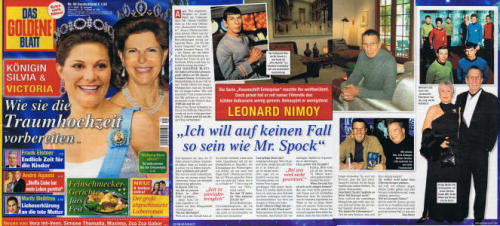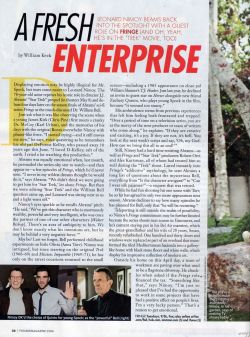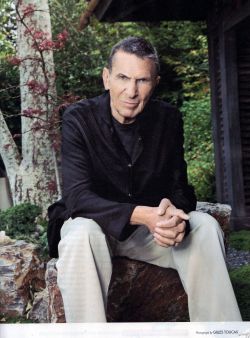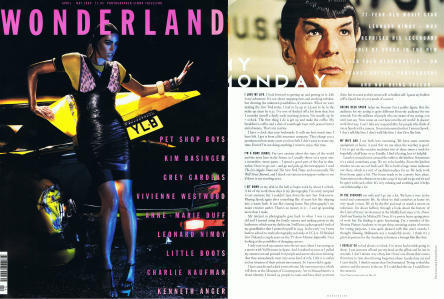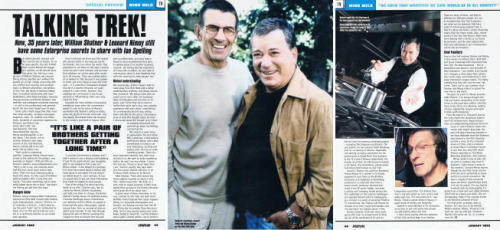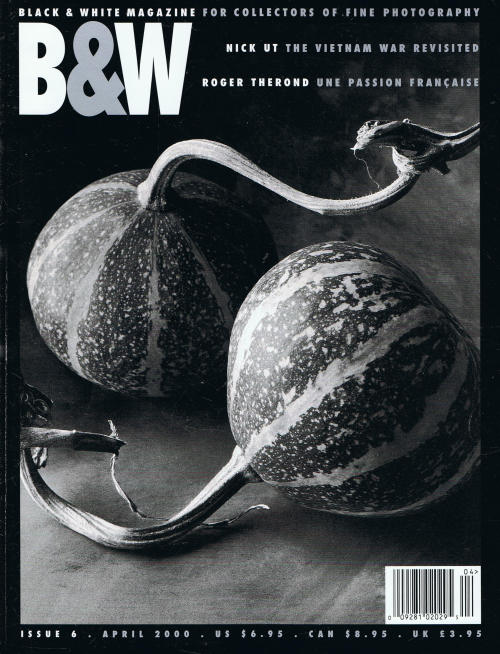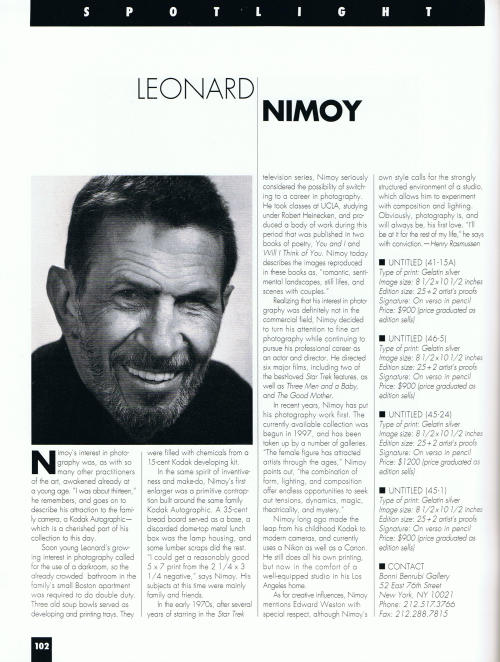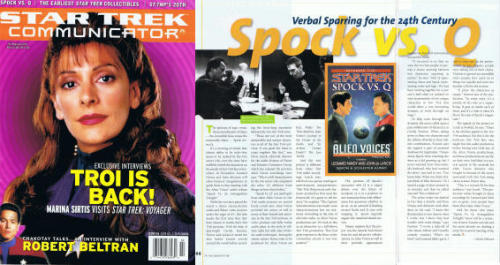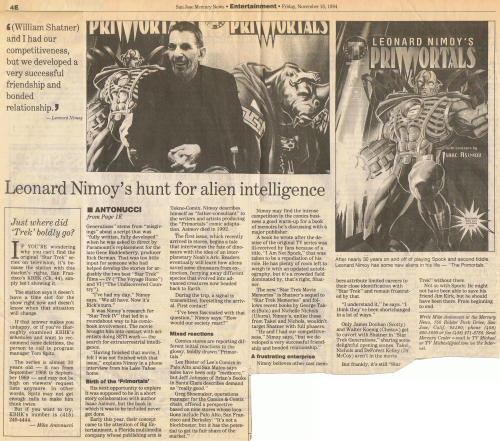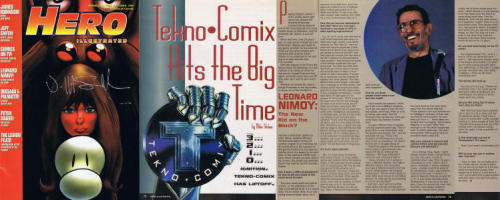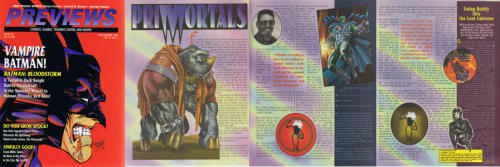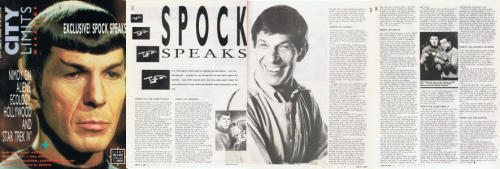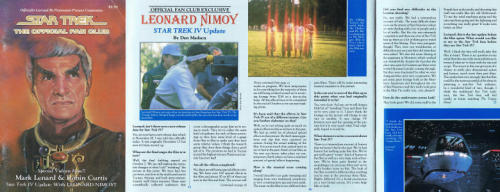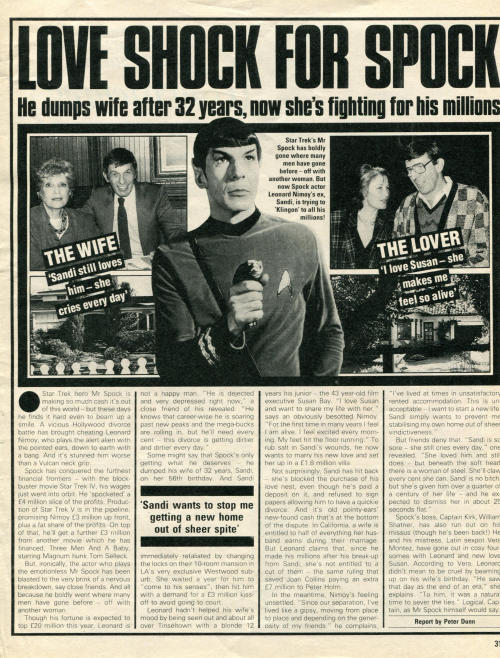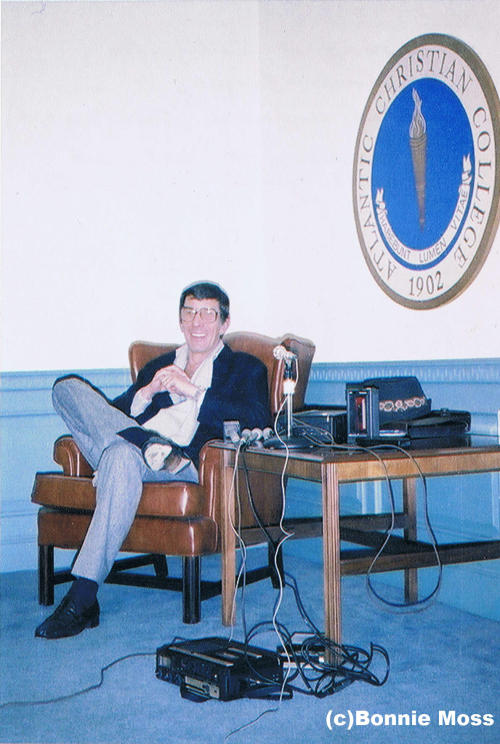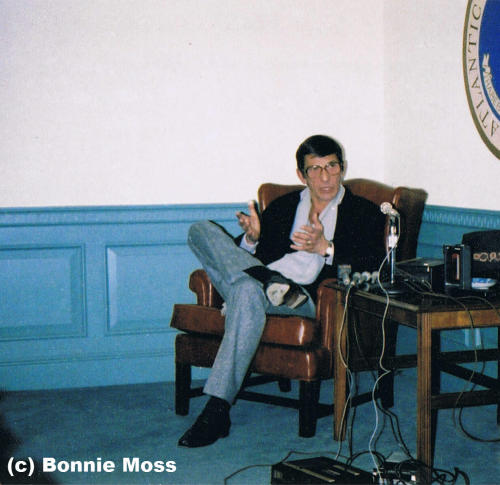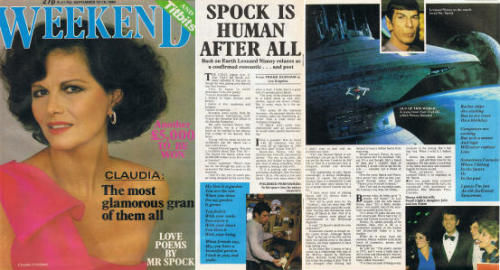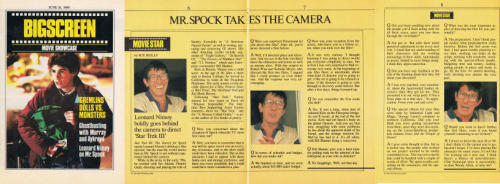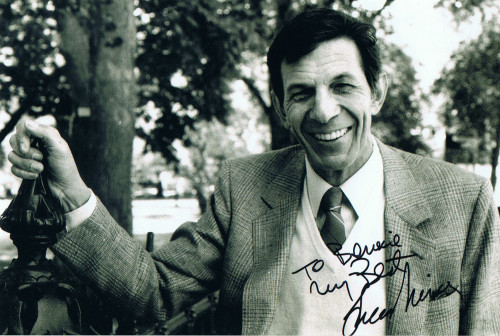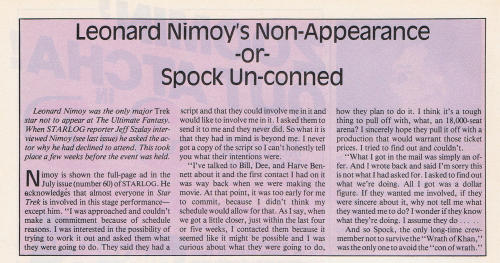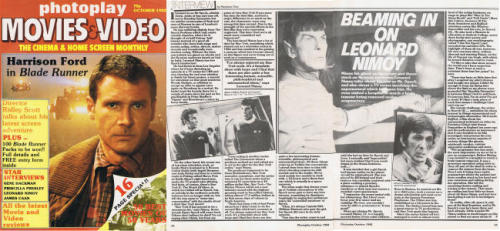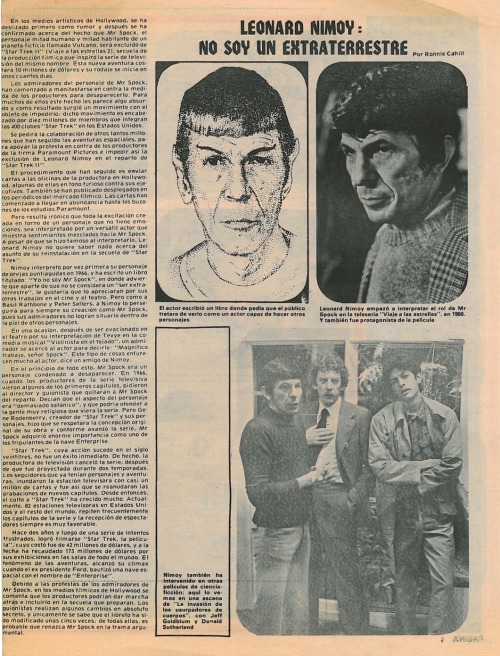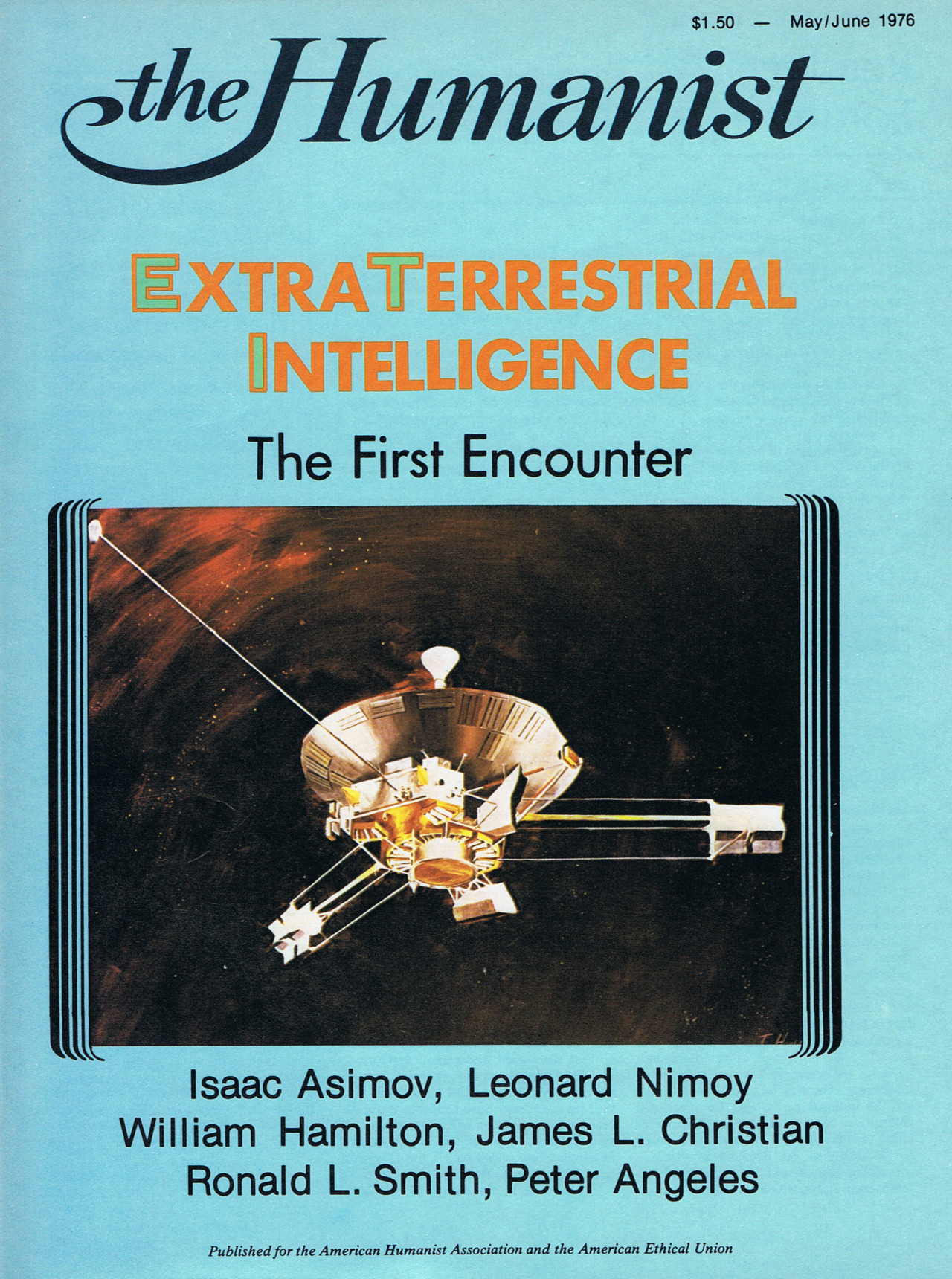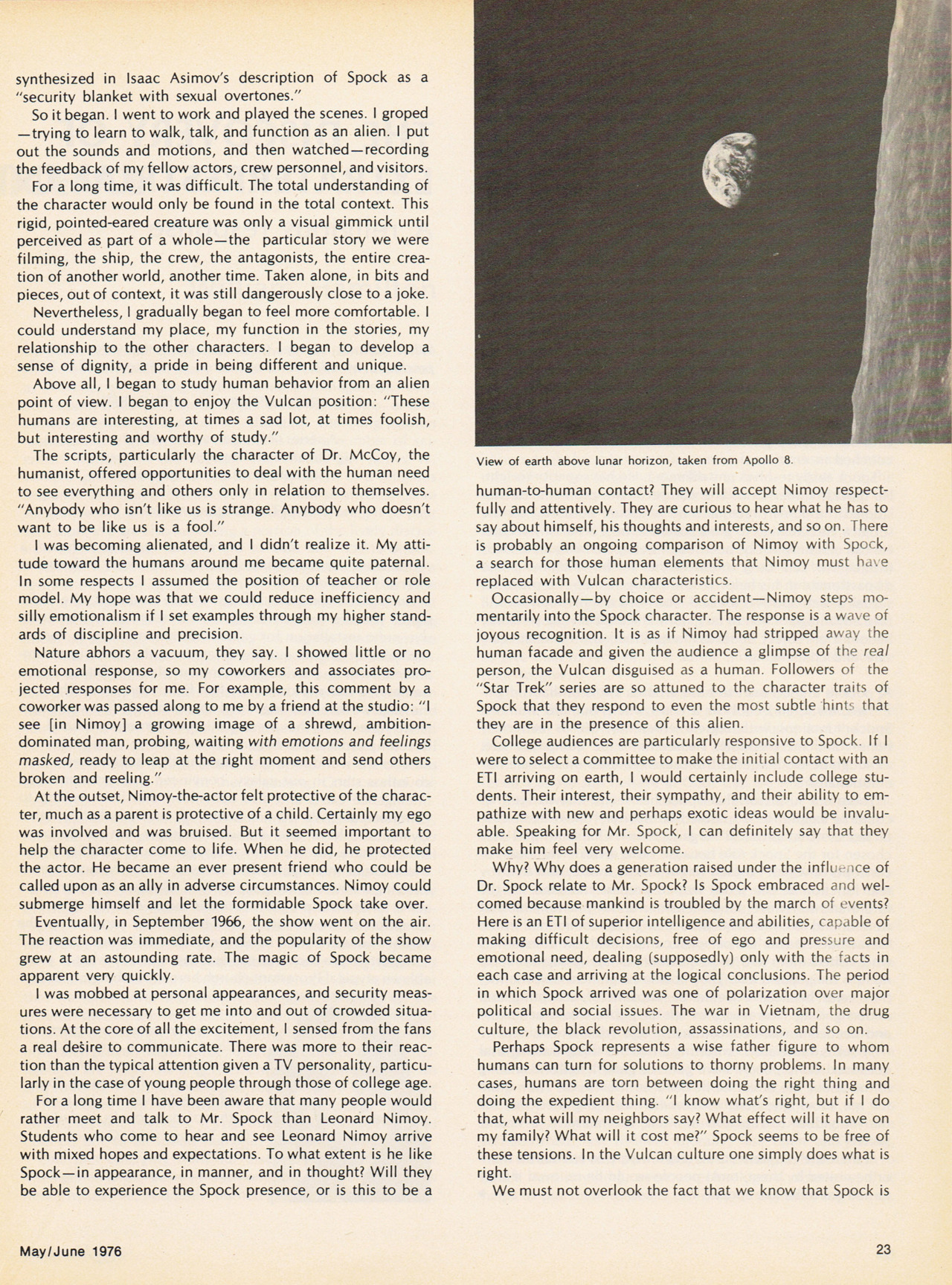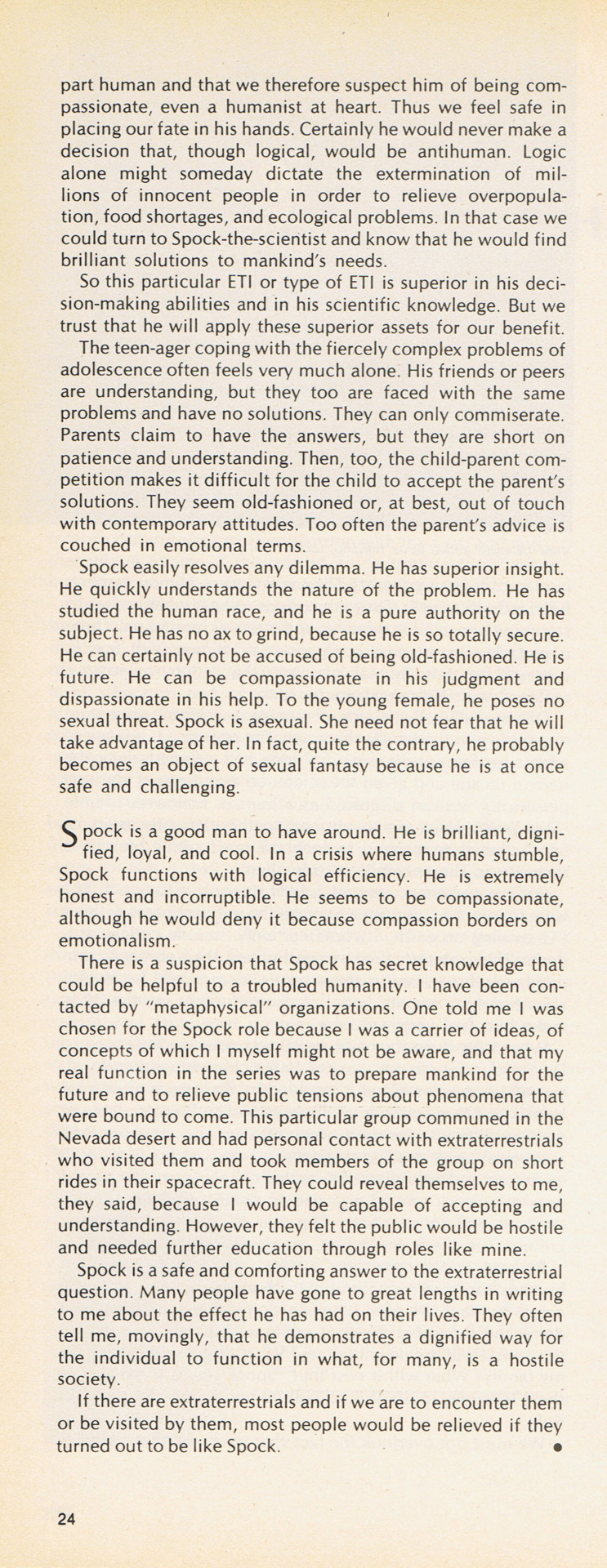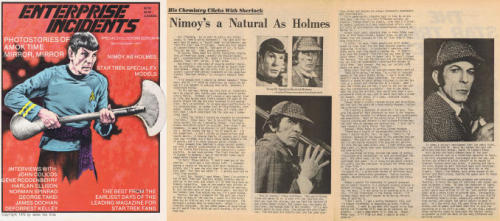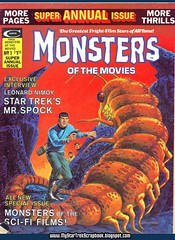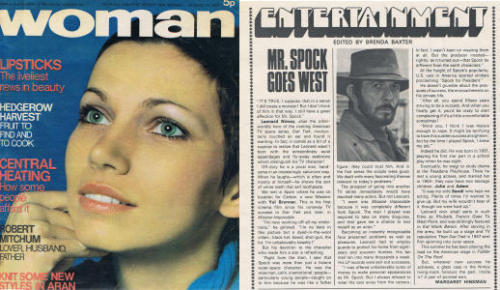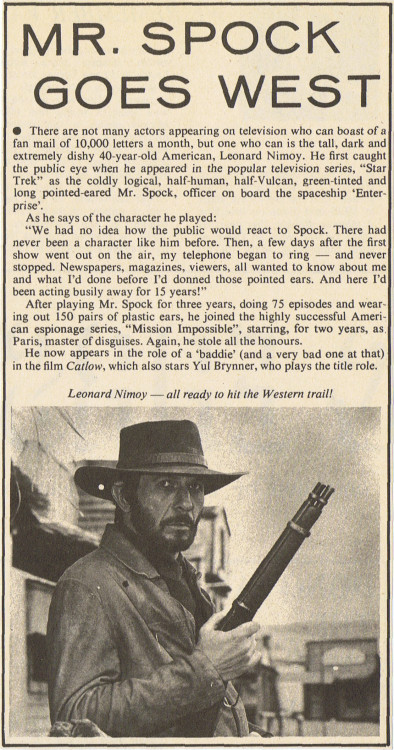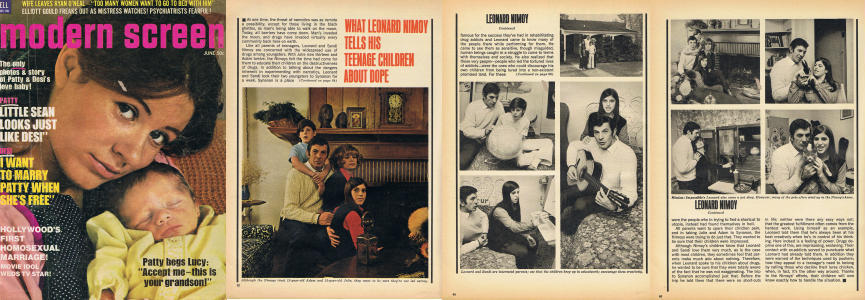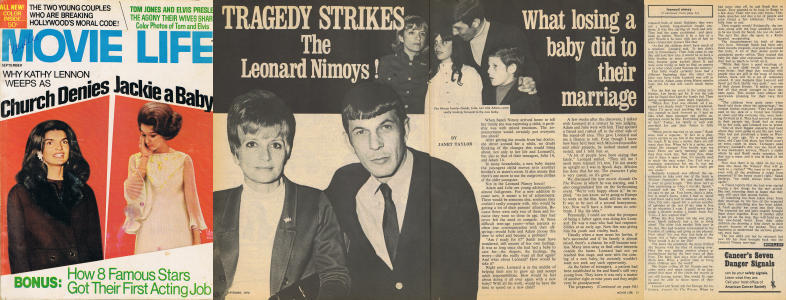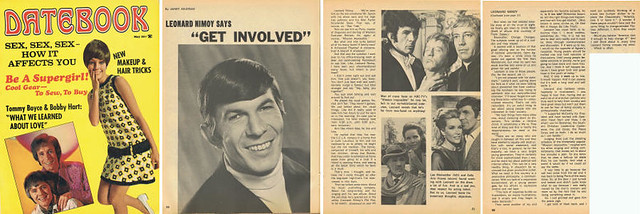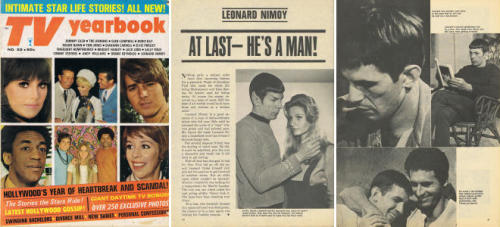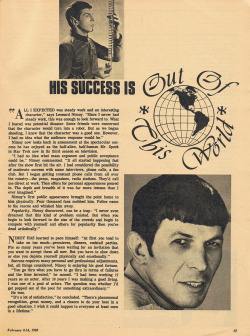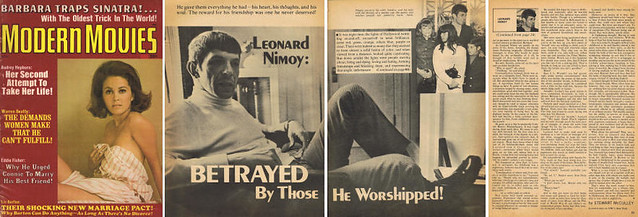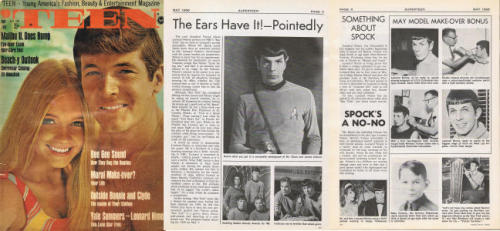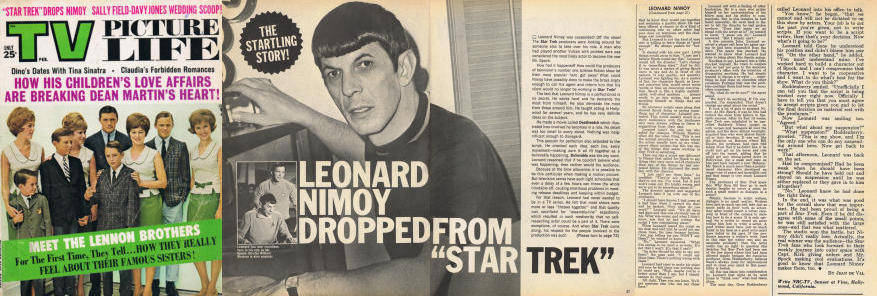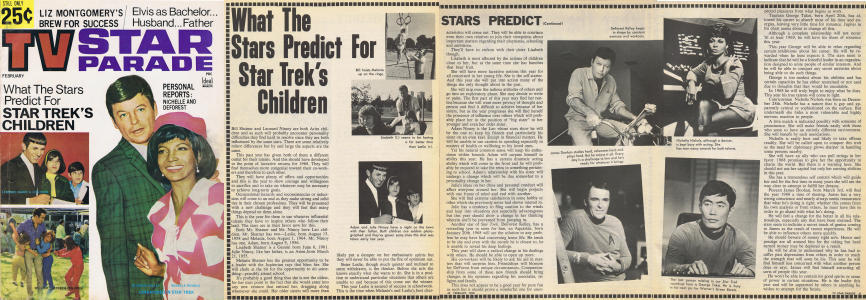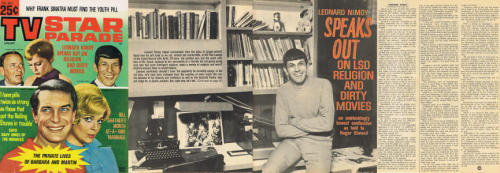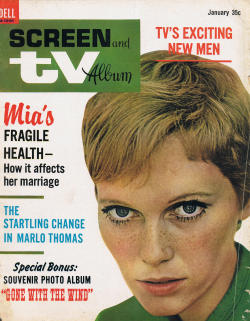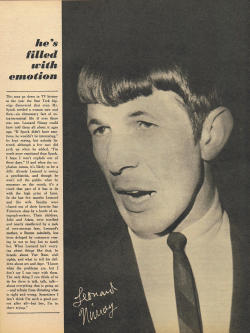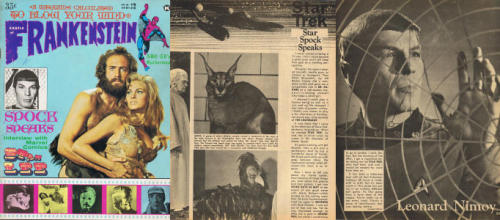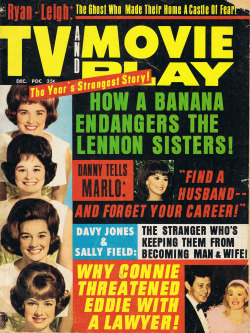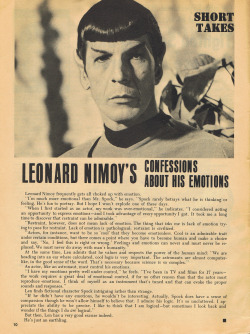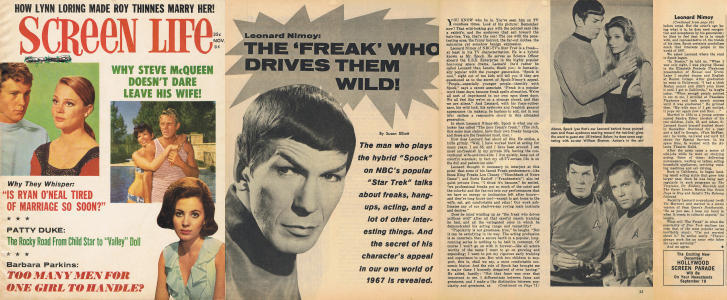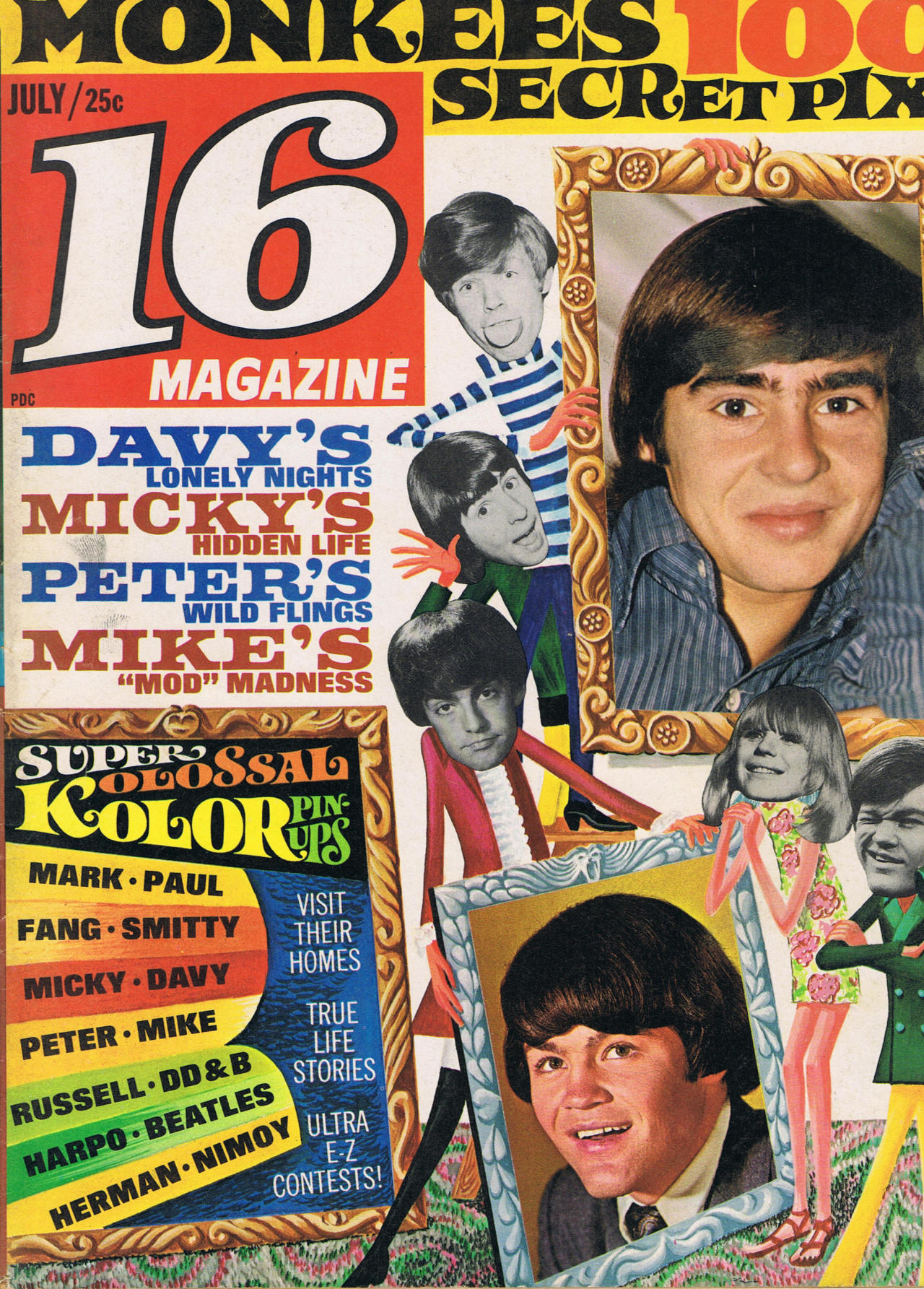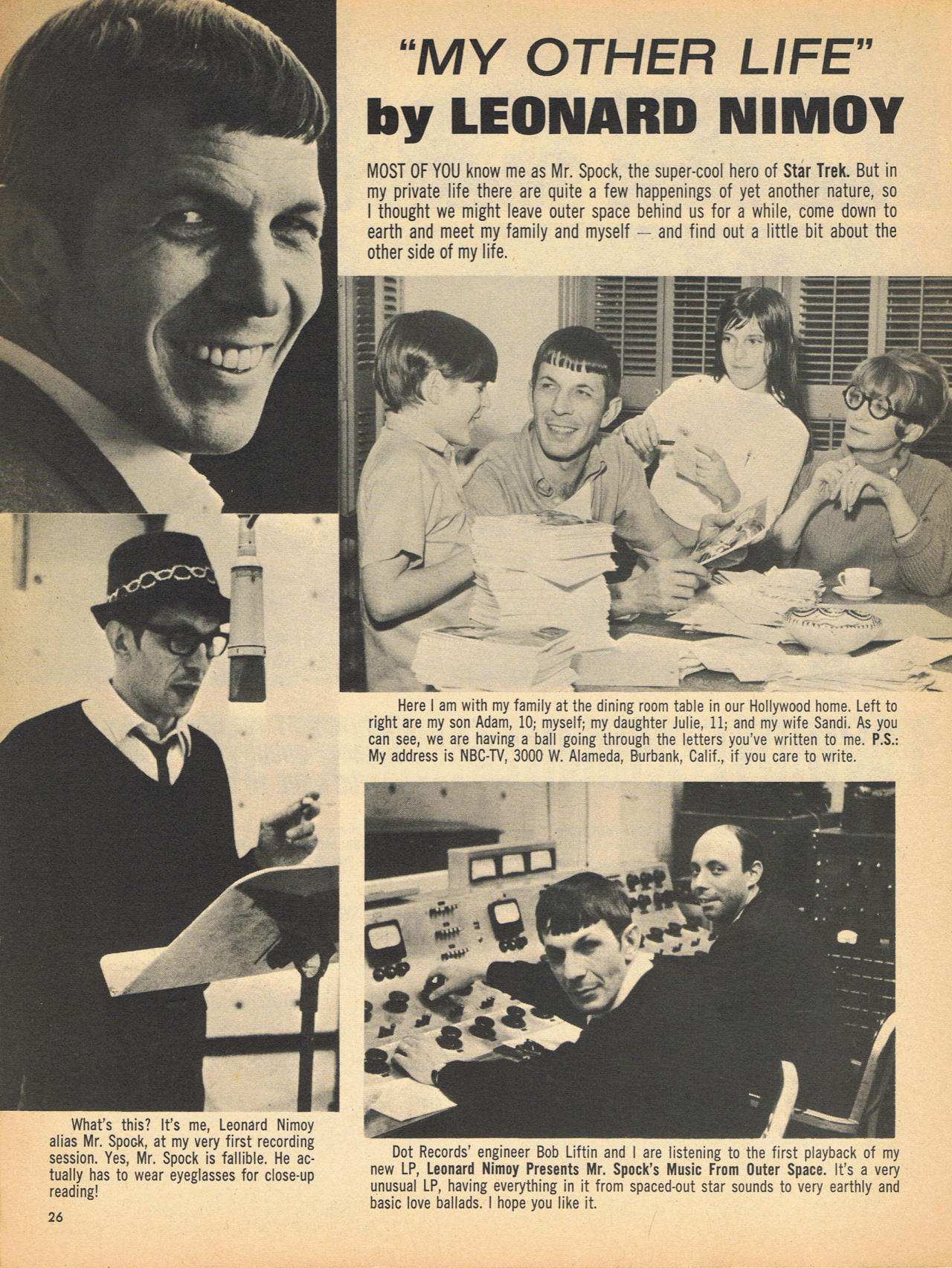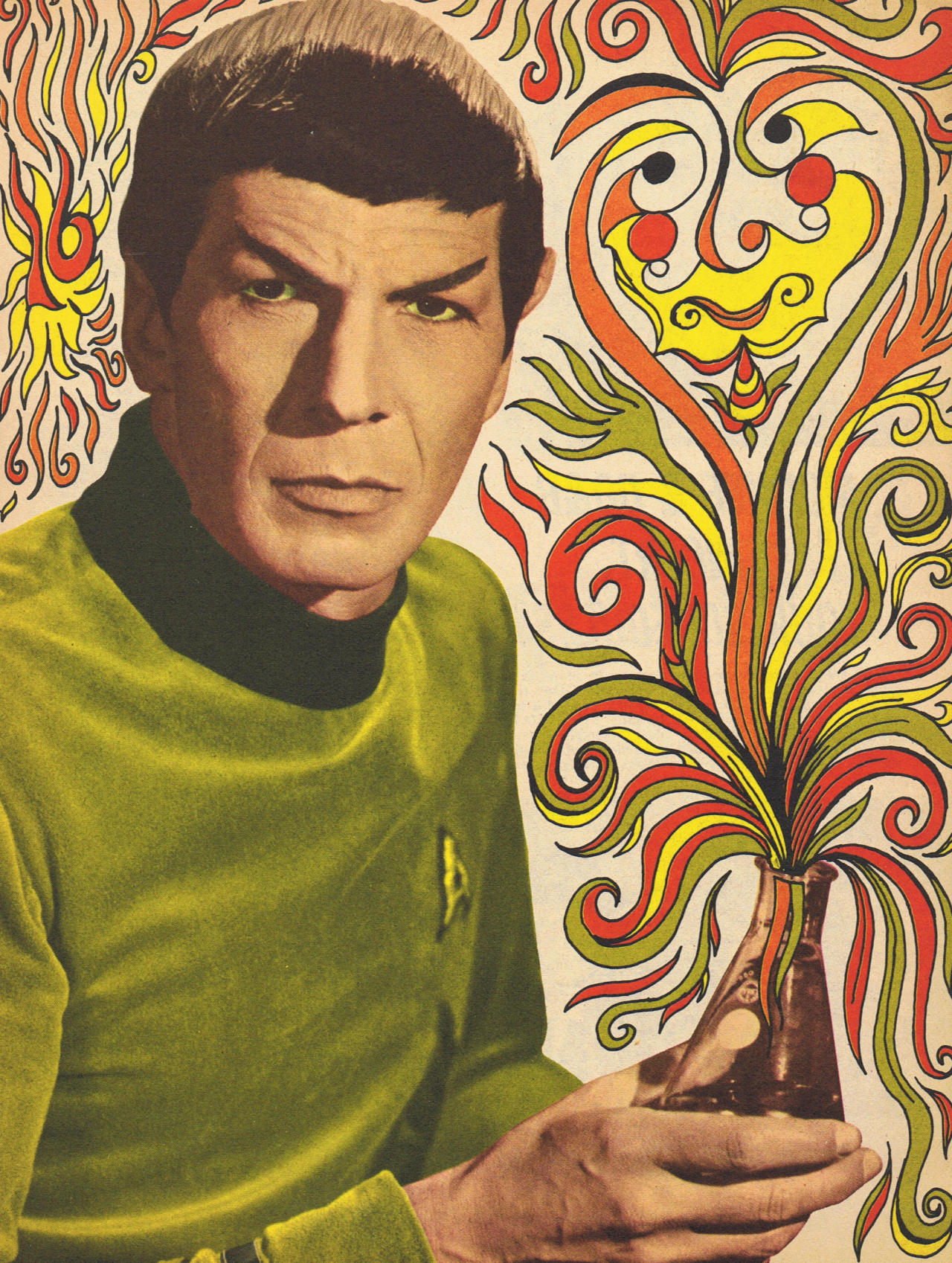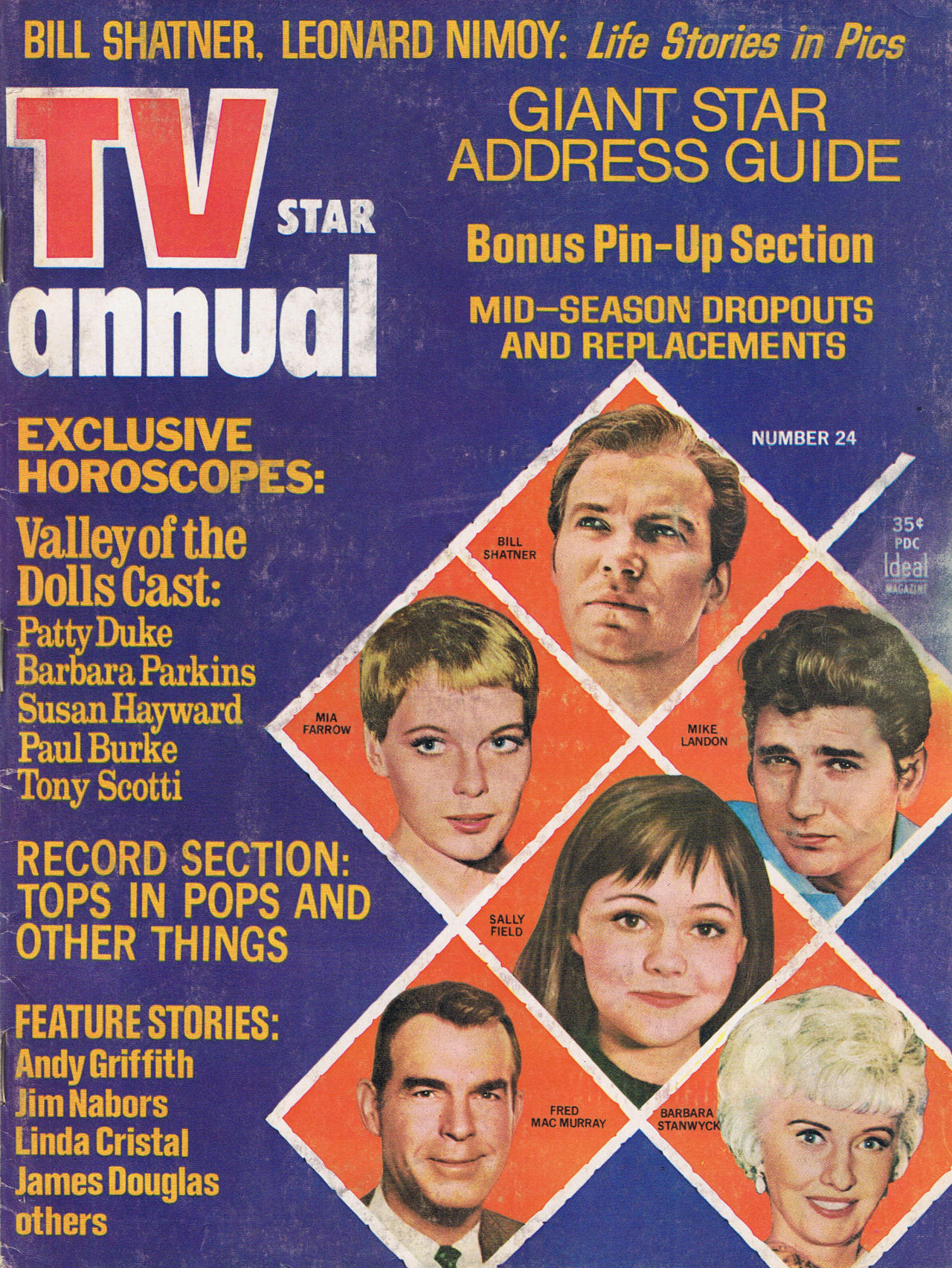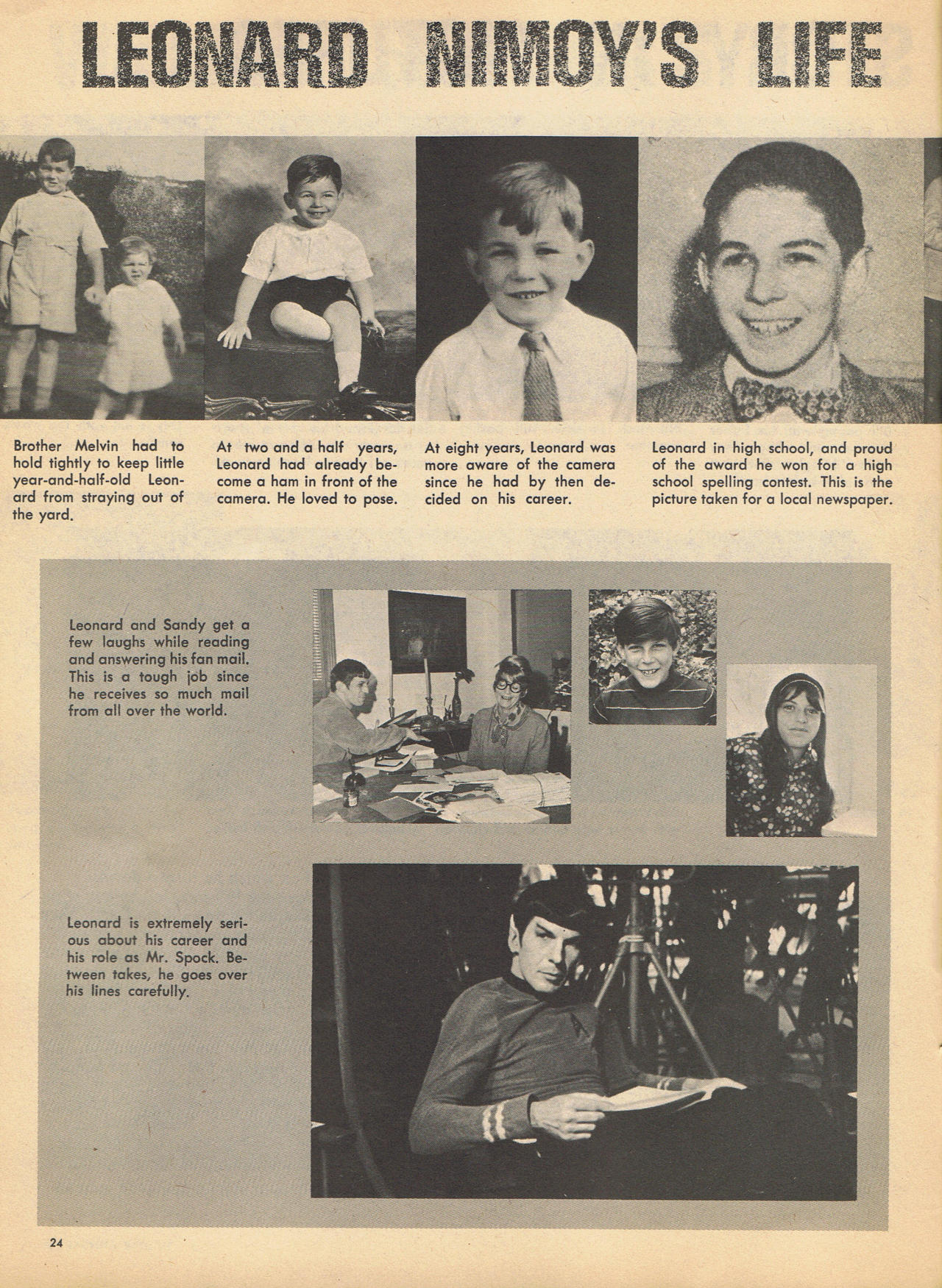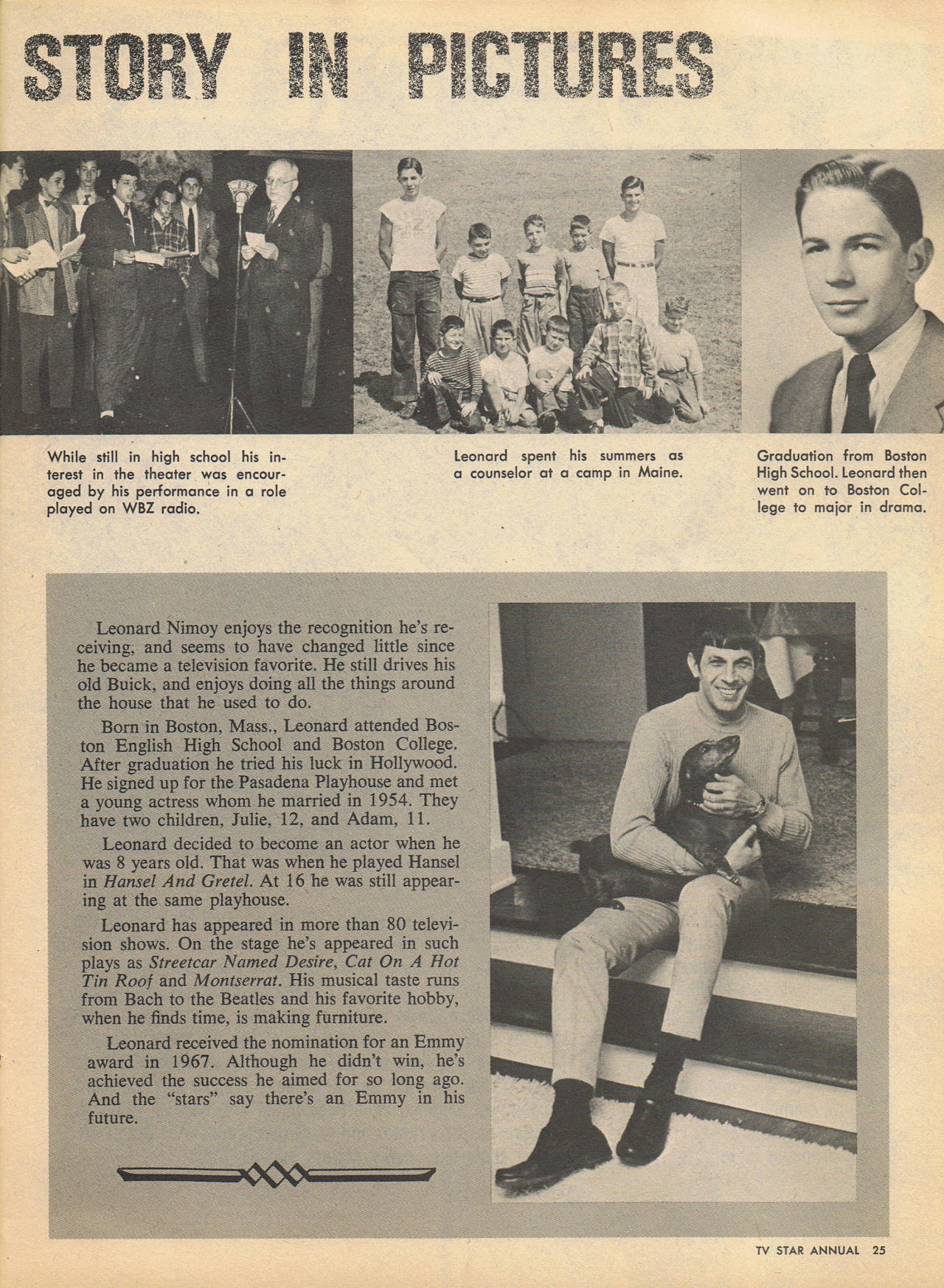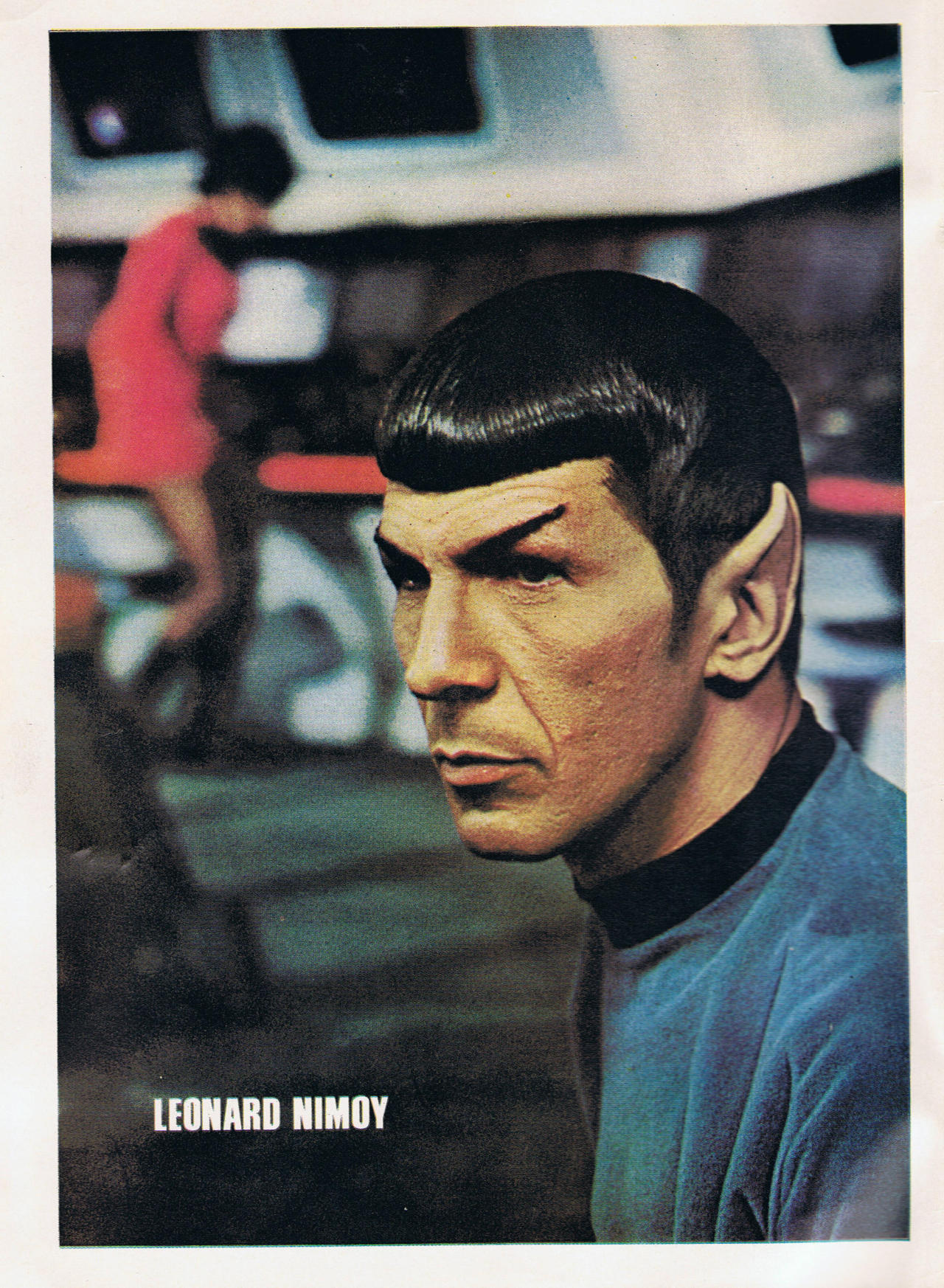InterviewsPrint* Timeline / A-Z
Fringe Season 5: William Bell could be back, says Leonard Nimoy

“It was explained to me that we’re opening up a whole world, and William Bell is being recreated as something else,” Nimoy told us of his Season 4 role. “He’s in another universe and has taken on other characteristics. There were challenges in the character itself that were attractive to me. I could play aspects that I haven’t played in a long time, so it was very welcoming to me.”
“The William Bell character started as a very intelligent and rational character,” says Nimoy of Bell’s arc. “I think he’s still very, very intelligent, but I’m not quite so sure that he’s rational anymore. I think you’ll see some behaviour in the finale that have taken him quite a distance from where he started.” Source: SciFiNow
Star Trek The Official Magazine, available since May 8 from Titan Magazines. While much familiar ground is covered - why he chose acting for a profession, the mistake of calling his first book I'm Not Spock, starting a second career as a director, the ascribed role of guardian of Trek, Spock's impact on society - the interview still manages to stay fresh and interesting. The second part focuses on his photography, philanthopy and also briefly covers his appearance on Fringe.
BU Today
Date 05.16.2012
By Amy Laskowski
Leonard Nimoy will also receive honorary degree
When it was announced at Senior Breakfast that actor Leonard Nimoy, best known for his role as Mr. Spock in the iconic 1960s television series Star Trek, would receive a Doctor of Humane Letters degree at BU’s 2012 Commencement, the room erupted in cheers, many seniors spreading their fingers in the Vulcan salute he made famous. (more)
CNN
May 11th, 2012
By Henry Hanks
Two years ago we spoke to Leonard Nimoy about what was to be his final acting role on "Fringe."
Just over a year ago, Nimoy returned to voice the role of William Bell in a partially-animated episode of the cult sci-fi series.
One "Transformers" movie and one "Big Bang Theory" episode later (both voice roles as well, mind you), viewers were stunned to see Nimoy return once again to "Fringe" in his first appearance on-screen in two years. So what brought him back?
"I think 'Fringe' is a wildly imaginative show," he told reporters on Thursday. "The writers and the creators of the show, the producers, are very bright and very theatrical. All the characters are fleshed out wonderfully and the chemistry amongst the cast is terrific. I wanted to be part of this project." (more)
E Online
11. Mai 2012
By Drusilla Moorhouse
…and Whether He'll Be Back
William Bell (Leonard Nimoy) is back on Fringe—and badder than ever.
Silly us: This whole season we thought David Robert Jones (Jared Harris) was the evil genius planning to take over the world, but turns out he's just a pawn in Billy Bell's monstrous plot. (Probably involving actual monsters, just chilling in an almond warehouse.)
So what exactly is his endgame? The not-so-retired Nimoy gave us some scoop about tonight's finale—and what's next…
"The character of William Bell started out to be rather [ambiguous]," Nimoy mused. "We weren't quite sure whether we were supposed to enjoy him or be afraid of him. At the end of the last season he seemed to come around to be less dangerous. This season, I think things have taken another turn—he's in another universe and has taken on other characteristics.
"You're going to see some interesting activities on the part of William Bell [tonight]," the OG Spock said, cackling. "This character has gotten himself out on a limb and is doing some wonderfully theatrical and bizarre activities. He has become a world of his own. Take that as a hint." (more)
Collider
May 11th, 2012
By Christina Radish
Leonard Nimoy Talks FRINGE Season Finale, the STAR TREK Sequel, THE BIG BANG THEORY, and More
Lately, you’ve been playing a lot of these bad guy roles, with William Bell and in Transformers 3. Do you prefer playing the bad guy rather than the good guy?
NIMOY: I don’t have a preference for bad people, no. I have an interest in playing a broad range of characters. Obviously, I’m mostly identified with a character who is very responsible, very solid and very intelligent, but there are plenty of questionable characters in my past career. I’m interested in exploring theatricality and characters with some dimension. William Bell certainly has that.
How long have you held onto the secret of your return, and what was involved in keeping that secret?
NIMOY: Well, I’m not sure exactly the amount of time. I would say it was somewhere around two or three months from the time that I knew I was going to do it until now. I’m a sucker for a good role and J.J. Abrams, the executive producer of the show, is a friend of mine. When he calls, I take his call. The writers and producers, Joel Wyman and Jeff Pinkner, and the cast, are a wonderful bunch of people and I enjoy being there. When they called and asked me if I would do it, it was pretty easy to convince me that there was an interesting challenge in the character and a very wonderful company to work with. (more)
NBC Chicago
Friday, May 11, 2012
By Scott Huver
On being swayed by the prospect of digging even deeper in his “Fringe” character:
“The character of William Bell started out to be rather ambivalent. We weren’t quite sure whether we were supposed to enjoy him or be afraid of him. We couldn’t quite figure out what his motivation was. At the end of last season, he seemed to come around to be less dangerous. This season I think things have taken another turn. He’s in another universe and has taken on other characteristics. There were challenges in the character itself that were attractive to me. I could play aspects of a character that I haven’t played in a long time, so it was very welcoming to me…Obviously, I’m mostly identified with a character who is very responsible and very solid and very intelligent, but there are plenty of questionable characters in my past career. I’m interested in exploring theatricality and characters with some dimension. William Bell certainly has that. (more)
Spinoff Online
May 11th, 2012
By Steve Sunu
In fact, Nimoy’s entire career has been exciting for him, and the actor expressed how grateful he was to have had the opportunity to pursue and thrive in a job he loves.
“The journey that I’ve been on has been a very blessed journey,” he said. “When I was 17, I started out in the hopes of making a living as an actor and I feel I have been blessed with the kind of opportunities I’ve been given. I’ve acted all over the United States, I’ve acted in countries all around the world, I’ve acted on stage as much as I’ve wanted to, a couple times on Broadway, toured several times in various productions in the United States and met all kinds of wonderful people in wonderful cities — television, film, radio, commercials, I’ve had a taste of it all, I’m a very, very thankful person.” (more)
Huffington Post
September 30, 2011
By Gregory Weinkauf
Now, interviewing Mr. Nimoy is a pleasure, but it's also somewhat tricky. So storied a career -- six decades of elegant acting, dynamic directing, poignant poetry, velvety vocals! -- prompts in the jocular journalist a plethora of quirky questions, such as: "What's it like being totally amazing constantly?" and "Do you have any single daughters?" and "Pon Farr -- how's that goin' for ya?" But these we cast aside, for today we discuss Mr. Nimoy's career as a fine artist, a passionate lifelong photographer.
The occasion centers on Secret Selves, Mr. Nimoy's latest show and catalogue of photography, for which he recently presented seminars in two Los Angeles locations: at Westwood's beautiful Hammer Museum (where he covered the project and greeted the audience in conversation with the "new Spock," Zachary Quinto); and at Century City's elegant Annenberg Space for Photography (where he expanded the Secret Selves lecture into an exploration of the Sacred Feminine as well as a truly fascinating oral autobiography). Throughout, Mr. Nimoy appeared as a charming and sophisticated cultural hero at the top of his game. It was awesome. (more)
The Wall Street Journal
July 22, 2011
By Don Steinberg
On TV, Westerns had a similar rise and fall and eventual blast into space. In 1959, the three networks had 30 Westerns on their weekly schedule. When Gene Roddenberry pitched the idea for "Star Trek" to TV executives in 1964, he helped them understand by calling it "'Wagon Train' to the stars." The series "Wagon Train" featured a group of post-Civil War settlers headed west, encountering new dangers (and guest stars) in each episode.
"It's all about frontier, isn't it?" recalls actor Leonard Nimoy, who played Spock on "Star Trek." "The westerns were about that frontier, and our show was about the final frontier."
Virtually all of Star Trek's creators and actors had worked in TV westerns. Mr. Roddenberry wrote for "Have Gun Will Travel." Mr. Nimoy had worked on "Rawhide," "Gunsmoke" and "Bonanza"—most of the time playing Indians.
"Naturally when I got into science-fiction, I had to play an alien," says Mr. Nimoy, who grew up Jewish in mostly Catholic Boston: "I felt like the other."
In one "Trek" episode, the crew is transported to Tombstone, Ariz., on Oct. 26, 1881 for a reenactment of the famous Gunfight at the OK Corral. But Mr. Nimoy recalls a different episode that he believes was key in the Space-Western continuum: "The Enemy Within," in which Kirk's character is split into two people, a good guy and a bad guy.
"The writers had written 'Spock comes up behind the bad guy and hits him over the head with the butt of his phaser.' I said 'I don't think so. I think that would be appropriate in "Gunsmoke."' And that's when I created this neck pinch that would knock him out just by pinching him with my fingers. That's a metaphor right there for the crossover from western to science fiction." (more)
College Times
May 25, 2011
By Lauren Kawam
College Times: You started as Spock in 1966. What are your thoughts on the evolution science fiction through the years?
Nimoy: Science fiction has replaced the western that we used to do. Western is one of the frontier stories, and science fiction deals with those frontier issues. The way Indians used to be portrayed as the bad people, now we have Vulcans and other aliens as bad people. It has become the new final frontier, because of conflict between the nasty people there. Technology, of course, has evolved exponentially. It's just exploded and that has changed science fiction drastically. The first science fiction work I did was in 1960, I did a project called "Zombies of the Stratosphere." It's really funny to look back on it now, because it is so limited in special effects. The bombast and the gigantic creatures and explosions of today are just extraordinary. It's all about post-production these days.
Is technology one of the elements of a good science fiction story?
Well, the question is what's the story? To me, that's always important, because if you take away all the bombast and the crashes and fires and explosions, I'm interested in the story. Is there something intriguing? Sometimes it works, and sometimes it doesn't.
(...)
Spock has become a true pop culture icon. Why do you think this is?
I think people can really identify with him. At times, his wit is very clever. He's also very loyal and helpful. It's interesting – over the years, as much as we talk about Spock being a Vulcan and an alien and all that, if you really stop to think about it, he's really a human character. He's dealing with his own personal issues which are very human issues, because there's the conflict of logic and emotion in his life. And people get that and they understand that and relate to it. (more)
SCIFI- Nexus
May 18, 2011
By Geoff Johnston
Another interview leading up to Dallas Comic Con. Among questions about his photography, J.J. Abrams Star Trek, Zachary Quinto and I'm Not Spock, he was also asked what Spock would think about the actor's latest forays into the human condition and some of the questions he gets at those events. (more)
BU Today
May 9, 2011
By Amy Laskowski
BU Today: Where in Boston did you grow up?
Nimoy: I grew up in the West End of Boston. You know that sign on Storrow Drive that said, “If you lived here, you’d be home now?” Right over there, near the Elizabeth Peabody Playhouse, that’s the area where I grew up, Chambers Street, St. Joseph’s Church. The whole section was torn down.
I left Boston in 1951 to pursue a career in acting. I started acting on stages when I was eight years old. My first play was Hansel and Gretel, and I played Hansel.
You play the character of William Bell on Fox’s Fringe, which just got picked up for another season despite rumors it might be canceled. Were you concerned about that?
The writer and producers are extremely creative and very resourceful. They’re able to take these interesting ideas, and it’s fun to see where they’re going and be a part of it. I consider myself a retired actor. I do small parts on Fringe, but when I was acting full-time I was always concerned about shows being canceled. (more)
The Boston Phoenix
May 09, 2011
By S.I. Rosenbaum
LN: I sent you some e-mails -- did you get them? I sent you three, I think. So, what are you looking at?
PHX: I'm looking at your camera.
LN: Yeah, that was a family camera that I started using in the 1940s.
PHX: Do you still have it?
LN: Yeah.
PHX: Awesome. Now I'm looking at the Harry Rubin Credit Union.
LN: That's that front of the building where I lived, and the lady on the left is my grandma.
PHX: Did you take that?
LN: No -- this is great story. Some years ago, I was asked to narrate a documentary about the Vilna Shul, which is a synagogue up on Beacon Hill. So, they sent me the script, I recorded out here, I sent them the track, and when it was done, they sent me back the video. And I sit down to watch it with my brother in Boston, and it was about the Jews in Boston, and up comes this photograph which I had never seen before. It was our grandmother, in the picture. Evidently they'd gone to the Boston Public Library to find some old photographs of the West End, and this was one of the photographs they found. That's the front of the building where I spent the first eighteen years of my life.
PHX: Wow. What floor did you live on?
LN: On the third floor walk-up. The weird thing about it is the lady on the right lived downstairs, on the ground floor. She was Irish, and my grandmother spoke no English, so I often wondered how they communicated. It looked like they were having a conversation. (more)
Star Trek.com
March 23, 2011
By StarTrek.com Staff
Star Trek.com posted a three part interview with Mr. Nimoy prior to his upcoming birthday. In Part 1 Mr. Nimoy was asked why Spock smiles in the pilot, how people reacted to the character in the 60's, what project of his had deserved a better fate at the hands of the audience and which he is particular proud of, the advantages of photography as a creative outlet and more.
In Part 2 Mr. Nimoy talks about directing The Search for Spock and The Voyage Home, how The Motion Picture shaped Star Trek's future and his decision to accept Spock's death in The Wrath of Khan, his hopes and aspirations for The Undiscovered Country that weren't realized, that it was his idea to have Spock to appear on The Next Generation and why Spock wouldn't be a part of the proposed Phase II reincarnation of Star Trek on the small screen.
Part 3 moves on to the 2009 movie, the necessity to come up with the alternate universe concept, what it would take to entice him to into doing another appearance, his most prized memento from the show, William Shatner, gadgets from the show that have become today's reality and turning 80. (more)
SecondAct Career/Reuters
September 24, 2010
By David Ferrell
Photography is more satisfying than acting or directing because it is intensely personal and enables him to make a statement about the human condition, Nimoy says.
"When you're acting, you're working on somebody else's project and helping them to express an idea," he says. "You're part of a large and complex machine." As a photographer, "I'm a one-man operation. I control everything. I can get an idea in the morning, shoot in the afternoon and have a product in my hand by night time. I've always enjoyed the idea that I can physically make something." (more)
Las Vegas Sun
By John Katsilometes
Monday, Aug. 9, 2010
Maybe William Shatner hasn't been overacting all these years. Maybe he hasn't even been acting at all, if his performance Saturday before several thousand emotionally orbiting Trek fans is an indication.
Shatner is, to put it in Earth terms, a genuinely dramatic individual.
Shatner was a beyond-this-galaxy superstar at this weekend's Star Trek Las Vegas Convention at the Las Vegas Hilton. In this culture, Shatner doubtlessly needs no introduction. So during a co-headlining appearance Saturday afternoon with the comparatively easy-going but equally beloved Leonard Nimoy, Shatner swept onstage in the midst of Nimoy's question-and-answer session with fans in the temporarily renamed Gene & Majel Roddenberry Theater.
"Eh?" Nimoy said as he noticed his close friend appear unexpectedly as the crowd rose, stunned at the lacking-in-pomp onstage arrival of Captain James T. Kirk. "What is this, a camera?"
"Let me film you!" Shatner called out. "Let me film you!"
Oh, there was a camera. Among Shatner's many projects is a documentary he's working on, titled, "The Captains." He's recording footage of everyone who has ever portrayed a Starship commander in the "Star Trek" franchise's long history. He's recording a lot of his own activities, too, such as mingling with old friends and the fans he encounters at Trek conventions. There were 15,000 to choose from. (more)
Valley Advocate
August 05, 2010
By James Heflin
I was a bit unnerved. I'd just walked into a sparse, dimly lit, even futuristic room in the basement of Northampton's R. Michelson Galleries, and a genial gentleman in his 70s, a touch groggy from an afternoon snooze, smiled and said, "How are you? Good to see you again. Come sit down." He patted the bench he sat on.
I felt as if I'd been ushered into the presence of the Vulcan ambassador. This was, of course, Leonard Nimoy. Mr. Spock, for heaven's sake. I last saw him in 2007, so I was pleasantly astonished that Nimoy actually remembered me, one of the many geek-tinged fans who mostly know him for portraying the iconic half-Vulcan. That was pretty cool. (more)
The Berkshire Eagle
July 29, 2010
Charles Bonenti
Only in the last dozen years has he been able to devoted himself full time to art work. He has exhibited in museums before, but said this is his first solo show, admitting: "I'm excited."
He said he hopes "viewers will take away a sense of our common humanity" when they see the pictures.
There were threads of similarity, he observed, in his subjects' desires for power, or creativity, or to be perceived as bolder or more adventurous than they are in real life. Some were humorous; some very moving, Nimoy said, but the chance to be their other selves for a moment "seemed to touch something very universal."
Asked if he saw parallels in his work as an actor and as a photographer, he said both allowed him to create a body of work that lives on, but otherwise "I make no connection between what I did in the past and what I do now."
In his catalog essay, John Stomberg, deputy director the Williams College Museum of Art and an authority on photography, suggests, however, that the issues of identity pervading much of Nimoy's recent work may be related to his own coming-to-terms with the over-arching Mr. Spock.
"I was fortunate," Nimoy said, of his chance to play Spock. "People took him to heart for his great dignity, intelligence and integrity ... But I'm not very much like him. I'm much more emotionally oriented. (more)
timesunion.com
July 29, 2010
By Tom Keyser
To Leonard Nimoy, the idea, while not entirely logical, was intriguing.
In ancient Greece, during one of Plato's symposiums, Aristophanes, the famous philosopher-playwright, came up with a fanciful notion of what caused human angst and restlessness.
Here, let Nimoy explain in his own words. Remember, this is Nimoy talking in the present, not Nimoy portraying Spock in an episode of "Star Trek."
"He said that humans at one time were double creatures. We had two heads, four arms and four legs, and we were attached back to back in couples like that in all the various permutations of male-male, male-female and female-female.
"And these creatures, these humanoids, became powerful and arrogant -- although I can't imagine how they could be powerful attached to themselves like that."
He laughs at the illogic.
"But anyway," he continues, "he said they became powerful and arrogant, and the gods sent Zeus to solve the problem. Zeus used a big sword to split everybody in two and send them on their separate paths. And ever since then, Aristophanes said, humans have been searching for the lost part of themselves to make them feel whole again." (more)
timesunion.com
July 29, 2010
By Tom Keyser
In 2008, his friend Richard Michelson (he owns R. Michelson Galleries) spread the word around Northampton that Nimoy was looking for models willing to pose as their secret self. Over two days, Nimoy photographed 95 in a makeshift studio at the gallery. He chose 25 for the exhibit, of which 11 are life-size.
“I really had no idea what to expect. The whole thing could have been a bust,” Nimoy says. “But the people who arrived were so committed to the idea and so generous, and made themselves so vulnerable and available. It was really quite remarkable. It was a very exhausting, at times very funny, at times terribly touching, experience.” (more)
masslive.com
July 25, 2010
By Ray Kelly
Leonard Nimoy photographs expose 'Secret Selves'
Nimoy’s photographic work includes “Shekhina,” a series that explored the feminine side of God, and “The Full Body Project,” a collection of mostly nudes taken of obese women.
He said he has not decided on his next photographic project.
Nimoy has been approached to create “Secret Selves” in other communities, but he said he wants to first gauge the reaction at MASS MoCA.
“People have been touched by this,” Nimoy said. “People identify strongly with this process and they ask themselves, ‘What is my secret self?”” (more)
The New York Times
July 28, 2010
By Charles McGrath
For at least two of the subjects, the experience of being photographed proved transformative. A writer who posed with a violin but had to be shown how to hold it has since taken up the instrument for real. And Tammy Twotone, the transgendered former Marine, decided to stop living a double life. “During the day I would switch back to living the life of a male,” she explained at Mr. Michelson’s gallery, joking that she was Clark Kent during the daytime and Rita Hayworth at night.
“I had been wanting to fully transition for years but couldn’t figure out how to make the change,” she went on. “Mr. Nimoy was very blunt and straightforward. He sort of whittled things down, trying to get a sense of who I am, and at one point he asked, ‘How do you do it?’ I was stumped. No one had ever asked me that before. How do you do that? And a week or two after meeting him I decided to fully transition. I became much more relaxed, and it seemed like everything was a lot simpler.” (more)
A.V. Club
July 28, 2010
By Leonard Pierce
AVC: So the way they presented themselves—their image, the costumes, and all of that—it was entirely their choice?
LN: Oh, yeah. They all came with their own story. Each of them had written a brief statement about who they were in their obvious daily lives, and what their hidden or secret fantasy self was all about. They came with their own wardrobe and their own props or whatever.
AVC: Some of their self-conceptions were so ambitious that I had to wonder if they came prepared with all of it, or they worked it out with you in advance.
LN: No, you’re right. And it’s not only ambitious, it’s very generous. They came fully loaded. [Laughs.] I had no idea what to expect! We explained what we were after, and the whole thing could have been a total dud, but these people walked in, and really, it was a very powerful experience—at turns very funny, and at times very touching. It was really quite extraordinary.
AVC: So you didn’t find you had to coax anything out of people to reveal their secret selves?
LN: Of the 95, there were a handful who didn’t really know how to go about doing this. They just wanted to come in and have their pictures taken, you know. [Laughs.] But only a handful. The vast majority, by and large, came with very strong ideas about what their other hidden, or fantasy, selves were all about. (more)
The Boston Globe
July 25, 2010
By Cate McQuaid
“[The subjects] came in extremely generous and ready to make themselves vulnerable and transparent,’’ recalls Nimoy.
The morning Nimoy and his wife checked out of their Northampton hotel, the photographer says, “several of these people had gathered, waiting for us. They had been talking among themselves about the experience, and they wanted to talk more. They asked, ‘Would you join us?’ ’’ But the Nimoys had to decline. They had a plane to catch. (more)
Bennington Banner
July 23, 2010
John E. Mitchell
The work marks some major aesthetic departures for Nimoy -- it is his first using a digital camera, his first color series and the first to include men as subjects, as well as some other changes in the technical side. Nimoy says the techniques employed were all about the subjects in the photos and not his own personal whims.
"The nature of the project demanded color," he said during a telephone interview last week. "It demanded a total presentation of whatever these people brought to the session. The black and white would have done them an injustice, I think. It would have eliminated or discriminated against a lot of what was happening in front of the camera. Black and white makes its own comment, which I enjoy very much in certain situations, but in this particular situation, it was very clear to me that we had to see -- if you’ll pardon the pun -- the colorful aspects of these people. So I went to color." (more)
Boston Magazine
July 2010
By Jason Schwartz
Leonard Nimoy: Extended Interview
Are you nervous at all about your photo show’s opening?
No, I’m excited. A lot of people are coming from California. My family’s coming. It’s like a major event.
Are you going to charter a plane in?
I wish. I have considered it. But we’re not doing that, no. Too many people are coming in from too many directions at different times.
Well, it will be good for North Adams’s economy.
That’s true.
Back to Boston. Does it pain you that your old West End neighborhood doesn’t exist any more?
Very painful, yeah. Who was it, Thomas Wolfe, who said, "You can’t go home again"? Well, in the case of the West End, he really meant it, you know? It’s gone. It’s gone. I’ve been back there looking for my street, and the only way that I can identify anywhere near where I lived is by the St. Joseph Church, which still exists. We could see that church out the window of my apartment. I can get a rough idea of where we lived, but it’s all gone. The geography has totally changed.
Well, you know, the old jail on Charles Street is now a fancy boutique hotel.
Is that a fact? The Charles Street Jail is a hotel?
One of the fanciest in town.
Really? When did that happen?
A few years ago.
What’s it called?
The Liberty.
It’s called the Liberty? That’s funny.
They have a bar called Alibi.
That’s funny. Wow. My brother and I used to sell newspapers on Beacon Hill.
(...)
If I may ask, what’s the wildest thing that has happened to you at a convention?
Did you know I went to Vulcan a few months ago?
That would be pretty nutty. How did you get there?
There’s a town in Alberta, Canada, and it’s called Vulcan.
No kidding.
Would I kid you, a guy from Boston? No. It’s called Vulcan, and it was named Vulcan around 1915, by somebody who was interested in mythology, and they have a Star Trek center there. About a year and a half ago, I heard that the town had been asking Paramount for an opportunity to show a premiere of the Star Trek movie. And they finally got word that they weren’t going to get the movie — maybe because there’s no movie theater in Vulcan. We arranged for 300 people, drawn by lottery, to be bussed from Vulcan to Calgary for a screening, and then back. It’s a kick. The place really is Vulcan. They have a Vulcan bakery, a Vulcan bank, a Vulcan mortuary, and a Vulcan restaurant. You know, it’s all Vulcan.
When you say that, do you mean all the stores have the pointy ears?
No, I’m not doing any jokes here. I’m not doing any jokes about ridiculous, silly stuff. I mean, if you were in Newton and you had a Newton bank and a Newton bakery, this is what they have in Vulcan. So it’s a kick to see everything named Vulcan. It has nothing to do with jokes. It’s serious. It’s real.
Okay, before I go, can I make a fan request? I know you speak Yiddish, so can you please say "Live long and prosper" in Yiddish? All the Trekkies in Brookline will plotz.
Oh, my. The simplest would be to say, "Languh yoren osta lebn." It’s a typical Yiddish expression. Parents say it to their kids. It means, "You should live many years."
Can you say that again?
No! Once was enough.
Read more here.
Boston Magazine
By Jason Schwartz
June 24, 2010
So you brought together 95 people in a Northampton art gallery over two days, asked them who they thought they really were inside, and photographed them? The idea was to come as your secret self that you typically don't get to express, and I would do a portrait of that. We chose 25 to be in the show.
Did anyone stick out to you? The guy who looks like a wood nymph.
I saw that. It looks like he spent about four days rolling around in the mud. He came looking exactly like that, and he became sort of the poster guy for our show. (more)
Roddenberry.com
June 14, 2010
By: Ruby Moon-Houldson
Richard Michelson:
13) What all was involved in bringing Leonard Nimoy on board? He’s the voice for the audio version of your book.
What a wonderful icing on the cake. The Yiddish Book Center began a project to record Jewish short stories. They asked Mr. Nimoy to record the story, and I was thrilled.14) Was Nimoy your first and only choice for the audio book project?
First and only! Leonard and I had originally met at the Yiddish Book Center. He did a reading of Isaac Singer’s “Gimpel, the Fool.” It had long been one of my favorite stories, and he brought it beautifully to life; at the time I had no idea he would later do the same for my story.
Leonard Nimoy:
1) What drew you to it or endeared you to that book?
Mr. Michelson’s book touches me in a deep place. I lived with Yiddish speaking grandparents. They were a major positive influence on me and the language still has a great impact on my emotions.2) Did it bring back a flood of childhood memories as you read it? If so, any good ones you’d be willing to share?
I have vivid and emotional memories of my childhood experiences as the youngest member of a Jewish family. Michelson’s book puts me in touch with those powerful memories. I hold them dear.
Note: interview is no longer available at the source. More here.
TV Guide
By Damian Holbrook
May 2010
"We liken it to the post-Beatles Paul Mc-Cartney and John Lennon working on a song together," jokes exec producer Jeff Pinkner. Whether Bell and Bishop can really work it out remains to be seen, considering that even Leonard Nimoy, returning for his fourth appearance, isn't so sure that his enigmatic alter ego is to be trusted.
"I wouldn't count on anything with William Bell," laughs the Star Trek icon. "You just don't know which way this monkey is gonna fall."
Nor do we know if we'll ever see "Belly" again, once the smoke settles. As Noble puts it, the seemingly sinister scientist "takes us all by surprise and makes an extraordinary sacrifice for the greater good." And .while Noble will only allude to- "a wonderful redeeming moment for the character," anyone who can read between the lines knows that "extraordinary sacrifices" usually spell tragedy.
Also upping the odds of a Bell farewell is Nimoy's own recently announced retirement from acting, although the man who was and always will' be Mr. Spock remains logical about the future.
"I never say never. JJ. and his producers and writers treated me extremely well on the "Star Trek" movie, and they did a great job. My nature is to want to be involved with-people who can do very good work."
The interview is gone from the TV Guide page, but a reprint can be found here.
The Artblog
May 30, 2010
By Corey Armpriester
Corey Armpriester -You picked up the camera at age fourteen, Why did light take a hold on you at that time?
Leonard Nimoy – Magic. Expose the film to light and process it in the dark. Capture an image and make a product. Hold it in your hand. Hang it on the wall. Give it as a gift.
CA -You had you’re first photographic exhibition in 1973, what did you reveal about yourself in that show?
LN -I was searching. Exploring. Experimenting. Looking for a visual identity. (more)
UGO
May 20, 2010
By Alex Zalben
With all of that important stuff out of the way, we had to ask the one question so nerdy, so geeky, there was no way around not asking it: will William Bell be going up his alternate universe double in the season finale... And if so, will that evil double have a goatee?
After Nimoy’s laughter died down, he was gracious enough to give us an answer – and more than that, spoil a little bit of what happens:
“A goatee! [Laughter] We’re getting close to doing a spoiler here, but I think it’s safe to say there’s only one William Bell that you’re going to see Thursday night. You’re right. All of the others do have alternates. The alternates are fascinating. I watched last night’s episode [Over There, Part 1], and was delighted with the way the actors have taken on different personalities for their alternate roles. I was only given one William Bell to play. That’s the William Bell you’ll see in closure Thursday night.” (more)
TV Squad
May 20th 2010
By Jane Boursaw
I sat in on a conference call with Nimoy last week, and he had a few things to say about William Bell, the 'Star Trek' movie, his retirement, and the joy he feels seeing Zachary Quinto take over the role of Spock.
But first, let's talk about 'Fringe.' I think most of us would agree that William Bell is a mysterious character whose motives have never been quite clear. Is he good? Evil? Something in between? Should the 'Fringe' crew trust him? Nimoy said a lot of these questions will be answered in tonight's episode, 'Over There, Part 2.'
"He keeps telling Olivia that she should trust him," said Nimoy. "Maybe she has to. I don't know if she has any choice really, but there will be very strong involvement with Olivia and with Peter and particularly with Walter, which will, I think, answer a lot of questions." (more)
Los Angeles Times
May 11, 2009
By Geoff Boucher
Nimoy’s presence gives the franchise revival “a very important sort of approval – there’s a torch being handed off there,” according to Pine, and director J.J. Abrams describes the elder actor’s participation in the film as “essential to our goal to serve and celebrate the history of ‘Star Trek’ with this story and create something new and exciting.”
Nimoy, for one, never expected to put those pointy ears back on again. He was leery when approached by Abrams and screenwriters Roberto Orci and Alex Kurtzman but, after hearing them explain their vision of the latest chapter of the space epic, he was intrigued. (This Tuesday, by the way, Nimoy also drops in on the first half of the two-part season finale of “Fringe,” the Fox sci-fi series from Abrams, Orci and Kurtzman.)
“This is the first and only time I ever had a filmmaker say, ‘We cannot make this film without you and we won’t make it without you,’” Nimoy said with another one of those startling smiles. “J.J. Abrams said that – that’s a pretty heavy statement. And when you see the film you see how central the character is to the story they’ve told.”
Nimoy stands as “the figure of credibility” for the franchise, as Orci put it, which sounds like an unintended ding on William Shatner, the original Kirk and an actor who publicly lobbied for a role in this new $140-million film. Nimoy and Shatner remain good friends after all these years and one reason is an understanding of the benefits of selective silence.
“Bill and I have spent some time together, we have dinner periodically, and frankly it’s a subject that we avoid,” Nimoy said. “It’s not a fun subject right now. And I sympathize with him because I was left out of the ‘Next Generation’ films. It is what it is.” (more)
MovieWeb
May 17th, 2010
People have talked a lot about the fact that William Bell's character had to be scaled back a little bit when you were cast because of your availability. You're not in as many episodes as they were hoping to feature the character. Do you know what some of those things that they were hoping to do with the character that they didn't get to do, or do you feel like there was stuff that didn't get to happen?
Leonard Nimoy: This is actually news to me. I haven't heard this before. I don't think it's accurate. I was asked to do five episodes. I did. So, I don't know where that information is coming from. It's true that, in the first three episodes that I did for them, or even the first four, I would say that my involvement was minimal. In this final one, coming up next week, I'm heavily involved. I don't know of any other plans that they had, or anything about scaling back. I don't think it's accurate. They asked me to do five episodes, and I did.} (more)
The Wrap
May 14, 2010
By Brent Lang
Spock will live long and prosper, but as alter ego Leonard Nimoy made clear on a Fox conference call to promote his guest spot on "Fringe," he won't be the one wearing the pointy ears. He's ready to cede the role to Zachary Quinto.
Nimoy stuck to his guns, restating again and again that this time he plans to keep his promise to retire.
"I've been doing this for 60 years," Nimoy said. "I had decided not to do any more acting, but I was called back to do 'Star Trek,' which I though was a wonderful way to introduce a new actor to play Spock." (more)
Spinoff Online
May 13th, 2010
By Josh Wigler
Have you been watching the show pretty faithfully?
I follow as much as I can. I was not aware of the show — I shouldn’t say that, I wasn’t watching the show before all this started for me. When J.J. called me, I started working on kind of a steep learning curve, watching a bunch of episodes and getting an idea of what it’s all about. I was impressed. I was really impressed. I thought it was very surprising, the level of production quality.
I was also impressed with how hard these people work. The pilot episode that they shot in Boston, where you can see the steam coming out of their mouths because it was so freezing, freezing cold. I come from Boston, and I know how cold it is in Boston. I’m glad I wasn’t involved in that. [Laughs] I get outside on a location like that where it’s that kind of temperature and I can’t even say the lines. My mouth doesn’t even want to. These people work very hard, and I admire that.
[The publicist informs Nimoy that the pilot was actually shot in Toronto.]
Was it Toronto? I thought it was Boston. None of it was shot in Boston? [Pauses] Well, Toronto is cold, too! [Laughs] (more)
DVR Playground
May 10, 2010
By theTVaddict.com
Will the upcoming two part finale resolve the story?
There will be a major confrontation between the two characters. The last time I was here, I was performing brain surgery on Walter. But now we will see them spend some time together in a dramatic situation where we will get some more information about their relationship, the past, how they felt about each other, what they were doing, what they were trying to do and how it affected the universes… both universes. Both Walter and William have some stuff to work out, particularly with regards to their feelings about one another. In fact, there’s a moment I’ll tell you about where they start to get into it and Olivia says, “Hey, work that out some other time.” It’s a terrific moment. (more)
And what about the alternate William Bell, or maybe there isn't an alternate?
Nimoy: Well, that's what I'm talking about. The alternate William Bell. On the side that William Bell is on now, there was an alternate William Bell. And we'll find out what his story is all about in this episode. Am I clear about that? (Laughs.) Or am I definitely trying to confuse you? What am I trying to do here? I'm not trying to confuse. I'm doing the best I can. Fringe is a very complicated show, which is one of the things that makes it so successful. It's intriguing, constantly intriguing. There's no question you can answer in any definitive way that doesn't lead to another question. (Laughs.) So that's where we are. We're having a good time. ... (more)
Calgary Herald
April 21, 2010
By Eric Volmers
Yes, in the eyes of many, Nimoy will always be Mr. Spock. But the actor says he is comfortable that the franchise is far from over with the new cast.
"I think the fans have been very receptive," he says. "I think the fans get it, that this could mean future Star Trek (films). Look, Jimmy Doohan (the original Scotty) is gone, DeForest Kelley (the original Dr. McCoy) is gone, Bill Shatner and I are in our late 70s. It's time. If we want Star Trek to continue, I think this is a great way for it to happen."
Note: original article no longer available at the source. Try Google Cache here.
Toronto Sun
April 19, 2010
Kevin Williamson
Just when he thinks he’s out, they beam him back in.
How else to describe Leonard Nimoy’s enduring, at times conflicted relationship with Star Trek, the franchise that’s defined his career for more than four decades — regardless of how many times he swore it off or believed it was finished?
“Countless times, I thought it was done,” he admits on the phone from Los Angeles.
But this time, says the 79-year-old actor-director-photographer, there are no more possibilities. Spock, his pointy-eared alter-ego, will live long and prosper. But it will be without Nimoy. (more)
The Calgary Herald
March 22, 2010
By Volmers
"I don’t see it happening," says Nimoy, in an interview from his home in Los Angeles. "I’m comfortable. I’m not glad, I’m not sad. I feel like I’ve had a great ride with the character. . . we started making Star Trek pilots in 1964. I’ve been involved in Star Trek for 44, 45 years. It’s been a wonderful ride for me and it’s been great for my family. We got to do some very interesting work outside of Star Trek because of Star Trek and I’m very satisfied."
(...)
Currently, the actor can be seen in the recurring role of the mysterious Dr. William Bell in Abrams’ trippy, sci-fi series Fringe. While Nimoy praises the show and his character, he admits he did it largely as favour to Abrams. So will it be his final role?
"I certainly hope so," he says with a laugh. "I’ve been doing it long enough, so I hope so. I’ve had a great, great run and I have no unfulfilled dreams or aspirations."
The News Tribune
March 12, 2010
By Craig Sailor
He became a science-fiction character so iconic that even a new president’s demeanor has been compared to him. And yet Leonard Nimoy, the original Spock from “Star Trek,” is not ready to retire. He’s just going to be giving those famous pointy ears a rest. (more)
The Seattle Times
March 11, 2010
By Marian Liu
Q: Do you think "Star Trek" was robbed at Oscars?
A: It's sad that "Star Trek" has been so unrecognized over so many years. I was delighted that at least it won a makeup award. ... I think that I'm correct in saying that that's the first Academy Award that "Star Trek" has ever won. ... There've been some wonderful achievements in technology, in special effects, photography and story, ... but "Avatar" was an enormous accomplishment as a motion picture and still it did not win best director or best film. (more)
MyNorthWest
March 11, 2010
By Heather Bosch
When he joined the cast of Star Trek in the mid 60's. He says the setting was science-fiction action but it was the great stories that kept the series alive.
"That's why it's lasted so long. It's not just about ships, and chasing, and guns, and explosions. I mean we have our share of that, but there's also some very interesting ideas behind all of the episodes and they're good stories.
USA Today
Feb 01, 2010
By Mike Snider
It's a pleasure to speak with you again. Tell us about the part you play in the game.
Nimoy: I spent some time in front of a microphone doing voice work for them. I am essentially a tour guide or narrator. I don't do the Spock character. I'm an omniscient voice that tells the player what is going on (and) what to do next, 'Congratulations, you've just done this or that,' 'Now try this' or 'Think about that' or 'Make a left turn or a right turn if you want to do such and such' or so forth. (more)
CBC News
January 25, 2010
"I'm looking forward to making a root connection to Vulcan," said Nimoy, adding he wants to "shake some hands" and "make some friends" during his visit.
Nimoy said he no longer feels rooted to the neighborhood he grew up and began his acting career in.
"I grew up in the city of Boston in a neighborhood I felt very connected to," Nimoy told CBC News on Sunday from his home in Los Angeles, Calif. "The neighborhood was subsequently torn down and replaced by many expensive high-rise condominiums. When I go back there I feel rootless." (more)
Blaster
November 19, 2009
By Fred Topel
"In the episode that's going to air that I recently filmed, there's some more information about what happened between William Bell and Walter, which I think will be useful," Nimoy told reporters Monday at the Trek DVD/Blu-ray launch party in Los Angeles.
Nimoy said it was great finally to share screen time with Noble. "I did, I did," Nimoy said. "He's wonderful. I mean, he's got a handle on that character, and he does it brilliantly."
And that will be that for William Bell, at least for now, Nimoy said: His current deal for Fringe guest spots is complete. "We agreed that I would do three episodes," he said. "I have filmed three. Two have been on the air. One will be airing sometime in the near future, and that's the extent of my commitment so far. I think the work that I did served a very important purpose, which was to explain the alternate side and what the major problem could potentially be." (more)
The Huffington Post
November 19, 2009
By Jenna Busch
On Monday night, I was invited to participate in the red carpet event celebrating Tuesday's release of the Star Trek DVD/Blu-ray. Not only was it at the Griffith Observatory, somewhere I've always wanted to go, but the legendary Leonard Nimoy stopped to chat with me. I couldn't help myself. I had to ask about a little video he did years back called, “The Ballad of Bilbo Baggins”. It's gotten over a million hits on YouTube. I'm sure you've seen it. If you haven't, check it out here.
Nimoy couldn't have been sweeter about it. He laughed when I told him I had just put the video up on my blog that day. He said, “Ha! Now that comes under the heading of 'be careful what you do because it lasts a long time'! It's a great kids song. It's a charming kids song. I'm amazed to see...it's got over a million hits on the internet. It's great!” He also gave me a few thoughts on Star Trek's lasting appeal. (more)
COMINGSOON.net
November 17, 2009
By Heather Newgen
Leonard Nimoy recently said he feels the future of "Star Trek" no longer needs him, so when we talked to the actor at the Star Trek DVD/Blu-ray release party at the historic Griffith Observatory in LA, we asked him why. (more)
The Boston Phoenix
November 16, 2009
By Rob Turbovsky
If Leonard Nimoy’s acting work had been limited to that deliriously crazy music video for “The Ballad of Bilbo Baggins,” he’d probably still be celebrated by a lot of us. Alas, in a career that spans seven decades, Nimoy has achieved a status far beyond accidental cult-kitsch pop-stardom, even if he did direct Three Men and a Baby. (more)
Los Angeles Times
October 30, 2009
By Scott Sandell
"The idea was to invite people to reveal their secret selves, the self they wish to be or the self they hide from the world," said Nimoy, 78, who has been an avid photographer since his youth. "There was a measure of bravery in this by everyone involved. I had no idea what to expect. Some of the people walked in with these amazing stories, stories you couldn't anticipate or make up." (more)
Los Angeles Times
October 30, 2009
By Geoff Boucher
Wander around the home of Leonard Nimoy and you'll find very few mementos from all those years spent roaming the galaxy as Mr. Spock. He kept the last pair of pointy ears he wore on the classic television series, and on one wall of his bright and airy home office, there are two Hirschfeld drawings of the actor in his Starfleet uniform. But that's about it -- no movie posters, no plastic models of the good ship Enterprise, no tribbles on the mantel.
Instead, the walls and shelves reflect the passion of Leonard and Susan Nimoy for contemporary art; in fact, their collection would be envied by many gallery owners. But some of the most interesting pieces are the actor's own photography, and on Halloween night he will be at the Santa Monica Museum of Art for a one-night exhibition of selected pieces from his conceptual project "Who Do You Think You Are?"(more)
Los Angeles Times
October 27, 2009
By Geoff Boucher
Leonard Nimoy, who was coaxed out of retirement for "Star Trek" and then lingered in order to portray the mysterious William Bell on "Fringe," says it may be the logical time to say farewell to acting for good -- especially since the Bell role hasn't been a compelling one for him. (more)
L.A. Weekly
Steven Leigh Morris
Published on October 14, 2009
On October 17, the Company of Angels is throwing a bash to celebrate its 50th-anniversary season. To mark the occasion, the company is honoring Culture Clash, Robert Ellenstein and Leonard Nimoy.
Mr. Spock? What could he have to do with Company of Angels? Even Nimoy was a little surprised. “They must have dug my name out of the archives,” he says, from his Westwood office. It turns out Nimoy directed Company of Angels’ first production, in 1961, and worked through the byzantine and impenetrable city bureaucracy in order to secure permits to run what’s now the city’s oldest operating theater. (more)
Crave Online
Oct 12, 2009
by Fred Topel
Who would have thought I’d ever get to interview Leonard Nimoy, let alone twice in one year. The big coup was getting him for Star Trek, and to talk about Spock no less. Now he’s also recurring on Fringe, as the elusive William Bell. Last week showed the first of many returns as Olivia flashed back to her meeting with Bell in the twin towers of an alternate New York. Nimoy shared his thoughts on Fringe and sci-fi, and we can only look forward (more)
Starlog Part 1 & Part 2
October 09 & October 10, 2009
Allan Dart
Interview originally published in two parts. Starlog has since unfortunately been defunct. The interview is still available here.
“Several things attracted me to the role: [FRINGE creators] J.J. Abrams, Bob Orci and Alex Kurtzman, whom I worked with on the STAR TREK movie,” Nimoy begins. “I admire their talent and the work that they do. The series is at the very least intriguing. My character was somewhat of a blank slate, but we began talking about it and I was attracted to the opportunity to build an interesting and unpredictable character. I’m enjoying it a lot. William Bell is sort of a ‘master of the universe’—a brilliant man, a very wealthy man, very powerful. We’ll find out more about him in future episodes.” (more)
Los Angeles Times
October 8, 2009
Andrew Hanson
Normally, I watch “Fringe” like anyone else. Thursday night, I sit on my couch, give my TiVo a little head start so I can fast forward through commercials, and enjoy the episode, furiously scribbling notes onto a small notebook the whole time. That’s how everyone watches, right? (more)
Show Patrol
10.08.09
By Curt Wagner
When Leonard Nimoy was offered a role on "Fringe," he knew he was getting into another series with a cult following.
"I can't help but laugh," the actor most famous for playing Mr. Spock in "Star Trek," said during a Wednesday conference call. "The series is at the very least to say intriguing ... There's an opportunity to build an interesting and unpredictable character. I'm enjoying it a lot." (more)
Trek Movie
October 8, 2009
By TrekMovie.com Staff
Question: I was wondering, did you have any reservations on taking another role with the potential of such a fanatic following?
Nimoy: I love this question. I can’t help but laugh because you’re absolutely right. It’s an interesting set of circumstances. What attracted me to it was several things. J.J. Abrams, Bob Orci, and Alex Kurtzman, who I worked with on the Star Trek movie, I admire their talent and the work that they do. The series is at the very least to say intriguing. The character was somewhat of a blank slate, but we began talking about it and, therefore, attracted because there’s an opportunity to build an interesting and unpredictable character. I’m enjoying it a lot. (more)
IGN
October 8, 2009
Christopher Monfette
In an interview reported by IGN Leonard Nimoy doubts he'll get a call again:
"My understanding is they're working on a script right now," said Nimoy. "I expect there's going to be some time before they really know exactly who they need and what they need. I frankly, frankly doubt that I will be called upon again. I think I was useful in his last film to help bridge between the original characters, the original actors, and the new cast. They have a wonderful new cast in place, and I'm sure they'll move ahead with them. I don't see, at the moment, why they would need me in the next film, although, if they called me, I'd be happy to have a conversation about it."
When asked about his reaction to having been included in the J.J. Abrams reboot, Nimoy replied, "It gave me a sense of validation after all these years. I had been out of it for some time, as you're probably aware. There were several Star Trek series in which I was not involved and Star Trek movies in which I was not involved. This was a re-validation of the work that I had done, the work that we had done on the original Star Trek…I had a great time working on the movie. I think they did a brilliant job, and I think the audience response shows that that was the case and has reinvigorated the franchise."
SF Universe
October 8, 2009
By Cynthia
Yesterday, the marvelous Mr. Leonard Nimoy spent part of his afternoon with a group of reporters to talk about his role in tonight’s episode of Fringe. But since he couldn’t reveal too many details about the mysterious William Bell, we got him to talk about other things like the state of science fiction on TV, the difference in TV production from Star Trek to now and his love of photography.
As someone who’s watched Star Trek most of her life, it was a real thrill to talk with an actor whose voice carries so many memories. He was warm and thoughtful but the best part was his laugh, a sound he let loose right after he was asked the first question. I wish I had a tape of it to play for you, but you’ll just have to imagine that deep, vibrato as he chuckled over a question I’m sure he’s been asked many times. (more)
Wired
October 7, 2009
Hugh Hart
When Leonard Nimoy returns to sci-fi series Fringe Thursday in the role of genius mogul William Bell, fans can expect to get a baby-step closer to understanding the man behind a global conspiracy that has driven the series’ back story from the beginning.
During a Wednesday conference call, Nimoy promised an intense scene with FBI Agent Olivia Dunham (played by Anna Torv) in the upcoming show, which airs Thursday at 9 p.m. EST on Fox.
“We will learn a lot more about their relationship and we will be told what William Bell’s intentions are, although we’re not sure that everything he says is accurate,” said the Star Trek veteran.
Nimoy (pictured) made his debut as Bell in the Season 1 Fringe finale, which hinted at an alternate universe riddled with “soft spots” enabling Agent Dunham and her associate Peter Bishop (Joshua Jackson) to straddle the time-space continuum.
Nimoy’s take? “You’d have to ask Stephen Hawking,” he said. “I’m not a scientist and can’t tell you if there’s a soft spot through which you can slip into an alternate world, but I think Fringe deals with that question in an intriguing way.”
On the Star Trek front, Nimoy said he felt his contributions to the original series were “validated” by appearing in last summer’s reboot, powered not coincidentally by Fringe co-creators J.J. Abrams, Roberto Orci and Alex Kurtzman.
However, the 78-year-old actor does not expect to reprise Spock Prime in future installments. “I frankly doubt that I will be called upon again,” he said. “I was useful in this last film to bridge between the original actors and the new cast but I don’t see why they would need me in the next film.”
As for his Dr. Bell character, Nimoy shoots another episode in two weeks but cautioned that future Fringe appearances have yet to be firmed up. Meanwhile, the actor will be preparing an exhibition of photographs to be staged next year at the Massachusetts Museum of Contemporary Art.
“I think of myself as an ocean liner going full speed for a long distance,” Nimoy said. “When the captain pulls the throttle all the way back to stop, the ship doesn’t stop immediately, does it? It has its own momentum and keeps on going.”
IGN TV
October 7, 2009
Ramsey Isler
Spock is back on TV this week as the mysterious William Bell.
US, October 7, 2009 - In the this week's new episode of Fringe, "Momentum Deferred", Leonard Nimoy makes his much anticipated return as the mysterious, dimension-hopping William Bell. IGN joined in on a conference call with the veteran actor who talked about his role on Fringe, his impressive longevity in the industry, and his love of photography.
Nimoy was notably upbeat, jovial, witty, and lightning quick with his responses to a wide variety of questions. You wouldn't think that the man on the other end of the line was 78 years old. He laughed out loud when asked if he had any reservations about taking on another show with such a fanatic following, and said that he didn't mind because show runners J.J. Abrams, Roberto Orci, and Alex Kurtzman were people he enjoyed working with, and he jumped at the opportunity to play a "character with a blank slate. To try to create from scratch a character who had never been seen before, and only been referred to...it's great exploration for an actor."
Nimoy couldn't reveal much about the upcoming episode that brings the Fringe series back to where last season's finale left off. But he had much praise for everyone involved in the production of the episode. He gave many kudos to Anna Torv's work as Olivia Dunham, calling her "very interesting to watch, and very competent." He also lauded the work of the writers and directors and the work of the special effects teams. "In tomorrow's episode there are things that I wouldn't know how to do," he said. "I directed two Star Trek movies, and I don't know how they're doing some of these things on a television budget."
Blastr
October '09
Leonard Nimoy may have made his final appearance as Spock in the Star Trek reboot. He says he doesn't think the series needs him anymore. As plans for a sequel develop, Nimoy does not expect to be involved.
"I frankly, frankly doubt that I will be called upon again," Nimoy said in a conference call on Oct. 7 while promoting his appearance on Fringe. "I think I was useful in his last film to help bridge between the original characters, the original actors, and the new cast. They have a wonderful new cast in place, and I'm sure they'll move ahead with them."
Nimoy also joked about the new moniker, Spock Prime, meaning he is the Spock from the original timeline but clearly different from the Spock that Zachary Quinto will grow to be.
"That's right, I'm in the prime of my life, right," Nimoy laughed.
Still, the original Spock's appearance in Star Trek meant more than just passing the torch. Longtime trekkers choked back tears as Spock Prime confessed his friendship to young Kirk. Even though the Quinto, Chris Pine, Zoe Saldana, etc. cast is now established as the Enterprise crew, no one would object to another appearance by Spock Prime.
"I don't see, at the moment, why they would need me in the next film, although if they called me, I'd be happy to have a conversation about it," Nimoy said. "My understanding is they're working on a script right now. I expect there's going to be some time before they really know exactly who they need and what they need." (more)
Oct. 2, 2009
By Steven Leigh Morris
Leonard Nimoy (right) in a 1953 production of Sholom Aleichem's It's Hard to Be a Jew at Hollywood's Civic Theatre, then located on La Cienega Boulevard north of the Coronet Theatre. The director, Maurice Schwartz, appeared in the production's 1920 New York premiere for the Yiddish Art Theatre. Photo courtesy of Leonard Nimoy
On October 17, the Company of Angels is throwing a bash celebrating its 50th anniversary season. To mark the occasion, the company is honoring Culture Clash, Robert Ellenstein and Leonard Nimoy. And what does the original Mr. Spock have to do with Company of Angels? Even Nimoy was a little surprised. "They must have dug my name out of the archives," he told me this morning at his Westwood office. (more)
Daily Dragon Online
September 6th, 2009
Debbie Yutko
Daily Dragon (DD): You have published two collections of your photographs, The Full Body Project and Shekhina. What aspect of photography interests you most?
Leonard Nimoy (LN): I use it to express ideas. [It’s] all conceptual. I develop an idea that I want to express and explore, then I go with the camera. (more)
Plus Model Magazine
September 1st, 2009
By Jennifer Jonassen
You may not know it but Leonard Nimoy (best known as Spock on the classic TV show Star Trek) is (among many other things) a brilliant photographer. A couple of years ago he set out on a special project, which focused exclusively on female nudes. What is so special about that you ask? (more)
The Star
August 23, 2009
By Darren Zenko
(...)"With Nimoy's reprising of his signature role in 1979's Star Trek: The Motion Picture, sating his Spock-hungry fans, there followed 30 years of mutual affection. In recent years, though, the veteran of countless conventions had been feeling in the Trek fan community a certain lack of energy and excitement, what he calls a "habitual style" of fandom. That's changed, he says, since the release of J. J. Abrams' new Star Trek feature, in which Nimoy's aged Spock encounters his younger counterpart, played by Zachary Quinto." (...) "In Las Vegas a couple of weeks ago I asked how many people there were at a convention for the first time. Half the room raised their hand. We had a lot of repeats in the past; I was surprised to see so many coming for the first time." (more)
Blend Television
August 10, 2009
By David Wharton
Leonard Nimoy is probably as close to an elder statesman as sci-fi fans have these days, so it’s been quite a joy to see him having a career resurgence of late in the Star Trek relaunch and in FOX’s Fringe. He returns to that show tonight in the role of the mysterious William Bell, and we’ve got the full transcript of his interview from earlier this week. (more)
Starland
July 9th, 2009
By Dan Madsen
DM: Leonard, when you heard for the very first time that there was a new Star Trek film in the works and they wanted you to play Spock again, was there a part of you that said inside, “No, I’m done with that character?”
LN: There certainly was hesitation because I was very comfortable, after so many years away from it, with the idea that I would not play Spock again. I just didn’t think of myself in terms of doing that role again. But I thought at least as a courtesy I should go and listen to what they had to say. I had a wonderful meeting with JJ Abrams and Bob Orci and Alex Kurtzman. My sense of them was very different from the experience that I had had in the previous 12 or 15 years relative to Star Trek. I felt, frankly, that I was a sort of an outsider looking in for many years. My conversation with JJ and the others really gave me the sense that they were looking at Star Trek the way I looked at it from the earlier years on the original series and some of the better films that we did. They were very much in touch with my feelings about what made it work and they were particularly in touch with my feelings on what had moved me and excited me about being Spock. So I thought, “This feels different than the experience that I had been having with Star Trek for some time.” It felt very different. I thought this could be worth looking into. They had not had a script at that point, they were just considering writing something but they made it very clear that they intended to write a script that would importantly involve the Spock character. So they needed some sense that I would at least consider it because if I had said flat, “No” they would have to find a whole new direction. I didn’t say flat “no” and I did say, “I think you guys are interested in the things I am interested in. I will look forward to reading the script.” And that’s the way we left it. (more)
BIGFANBOY.com
Jun 26, 2009
By Mark Walters
Mark: Well obviously photography is something you're very passionate about. Looking at all these people that come to these conventions that are collectors, do you yourself have things that you collect that are personal to you?
Leonard: My wife and I collect contemporary art, which includes photography, but the focus is broader than that. Our collection is paintings, sculpture, collage, half photography. we've been doing it for almost 20 years now, and we have a pretty serious collection. We go to various museums and art fairs around the world to look at art and to buy it.
Mark: What's your most prized piece in your collection?
Leonard: Prized piece? That's like asking me which is my favorite kid. (laughter) There isn't a piece I don't love. Every now and then a piece has to go to up to be loaned for an exhibition some place, and I miss it. What we try to do is take a picture of it and put the picture on the wall. (more laughter) (more)
Tulsa World
June 21, 2009
By Michael Smith
Today's technology won't allow Leonard Nimoy to totally escape from business concerns, even when he's on holiday on a ship cruising around Greek islands.
"Leonard is out at sea but fortunately has Internet (service)," said Gary Hasson, Nimoy's agent, in relaying his client's e-mail answers to a few questions in advance of his appearing on Saturday at the 20th anniversary of Tulsa's Trek Expo. (more)
Tribune Newspapers
May 12, 2009
By Geoff Boucher
There is one scene in the new film in which Nimoy and Quinto meet and speak, which seems to test the conventions of comic-book physics but gave Nimoy a final scene with his old friend Spock that could be a heartfelt handoff.
"For me, that scene was almost like the fantasy a father would have about talking to his son," Nimoy said. "To offer some ideas, some guidance, affection and love. ... I was pretty much playing who I am today. I didn't have to search very hard to find the character I play in this movie. And I think that was the end. But you know, I've thought that before about Spock." (more)
USA Today
May 10, 2009
By Bill Keveney
Orci says Spock serves as "the connecting tissue" to the original Trek, which spawned multiple series and films over four decades.
"What a fascinating thing to see a character played out over 43 years," he says.
The elder Spock's actions are tied to the threat facing the younger Spock (Heroes' Zachary Quinto) and Kirk (Chris Pine). The half-Vulcan, half-human, who has scenes with Spock and Kirk, offers nods to Trek lore.
Nimoy, the only original cast member in the film, says he is flattered that the Spock role is continuing with look-alike Quinto.
"We talked about the struggle ... to find the balance between the emotional and the logical," Nimoy says. "We talked about how the makeup evolved. It took some time to find the shape of the ears, the color of the skin, the haircut, the eyebrows."
Recently, Abrams called again to ask if Nimoy would like to play Fringe's mysterious Bell. Nimoy signed on as the pivotal character for three episodes. "At least," Orci says.
Bell — "a mix of Howard Hughes and Bill Gates," according to Orci — is the founder of corporate giant Massive Dynamic and a former colleague of mad scientist Walter Bishop (John Noble). Like Spock, he is a genius, but he may use logic as a weapon, Orci says.
Nimoy asks: "Is he mischievous? Negative? Positive? Is he going to save the world or destroy it? What is he trying to do?"
Nimoy's scene Tuesday is with Anna Torv, who plays FBI agent Olivia Dunham. "There is an interesting character touch in the scene with Olivia that I hope audiences will enjoy, a slight idiosyncratic moment," he says. (more)
boston.com
May 09, 2009
By Derrik J. Lang
For Nimoy, 'Fringe' was comfortable fit
LOS ANGELES - Outside of Leonard Nimoy's Bel Air home, workers are busy constructing a new driveway, replacing flagstone with sleek cement as part of an ongoing conversion from Mediterranean to modern. Though the 78-year-old actor is also undergoing a metamorphosis of sorts, he isn't paving over his past.
(...) "I've never played America's richest man before," Nimoy cooed.
He has filmed one scene so far in New York with actress Anna Torv, who plays Olivia Dunham, an FBI agent assigned to investigate unexplained phenomena with Bishop and his son. After production moves to Vancouver for the second season later this year, Nimoy will appear in additional episodes "when they call me."
Something about Bell is very different from any character Nimoy has ever played, but he wants to keep that under wraps. What's not a mystery is why Nimoy was offered the part: He bonded with "Fringe" cocreator Abrams during his "Trek" resurrection. Nimoy had never seen "Fringe" before but was impressed with the show after watching a few episodes.
"It's not unlike any other show that's ever been done," said Nimoy. "It's just that the execution is so much more thoughtful and theatrical than what I've seen in the past."
Nimoy, surrounded by art in his house - including many of his own photographs - said the version of Spock he's portraying in the new film is more like who he is more than ever before because "I know where I'm going, and I know where I've been." Other than the "Fringe" role and possibly another "Trek" film, Nimoy doesn't have other on-screen commitments.
And that's exactly the way he wants it.
"I like being here," he said. "This is a great place to spend time." (more)
The New York Times
May 8, 2009
By Dave Itzkoff
Paramount Pictures Leonard Nimoy reprises a familiar role in the latest film version of “Star Trek.”
Leonard Nimoy is an author whose poetry collections include “A Lifetime of Love: Poems on the Passages of Life,” a photographer whose monographs include “Shekhina” and the director of seven films including “Three Men and a Baby.” He has also appeared on such television shows as “Mission: Impossible” and “In Search of…”
Oh, what the heck. Leonard Nimoy is Spock. Played him in three seasons of the original “Star Trek” television series as well as six feature films, including “Star Trek III: The Search for Spock” and “Star Trek IV: The Voyage Home,” both of which he directed. He can also be seen reprising his role as Spock — or is that Spock Prime? — in the newly released “Star Trek” film directed by J. J. Abrams.
We spoke with Mr. Nimoy earlier this morning about “Star Trek,” his famous role and an early encounter he had with the president. (more)
People
May 08, 2009
By Scott Huver
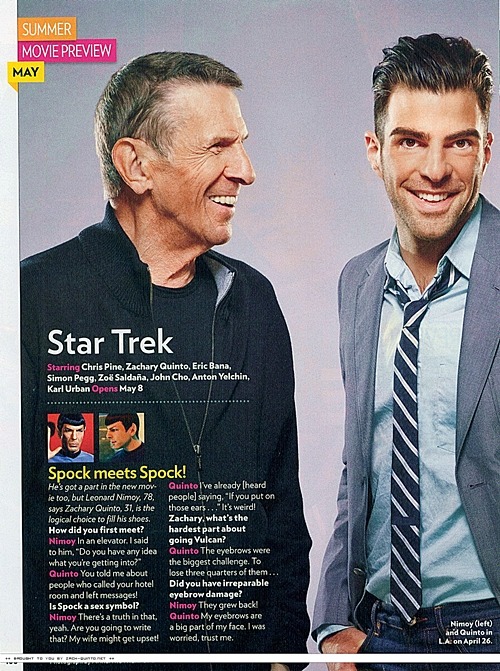 Spock on Spock: Leonard Nimoy and Zachary Quinto Sound Off
Spock on Spock: Leonard Nimoy and Zachary Quinto Sound Off
Leonard, was it fun to see someone else have to deal with the Vulcan ears, eyebrows and haircut?
Nimoy: Yeah, it was! I didn't have the severe problem with the eyebrows because mine weren't so prominent to begin with. I would pencil in the missing portion of the eyebrows so that I could get away with it.
Quinto: The eyebrows for me were probably the biggest challenge, just because my eyebrows are such a big part of my face. There's really no way around it and to lose three-quarters of them for six months...! Did you have any irreparable eyebrow damage over the years? Did they always grow back?
Nimoy: I asked about that before they shaved them: Will they grow back? They told me that they would and they did, but I think that over the years the more and more I shaved them the less and less they came back! (more)
Note: the title of the online edition differs slightly from the printed one, Spock meets Spock!.
Entertainment Daily
May 8, 2009
By Derrik J. Lang
‘Star Trek’ legend Leonard Nimoy ‘comfortable’ with mysterious new ‘Fringe’ role; Spock, too
LOS ANGELES — Outside of Leonard Nimoy’s Bel Air home, workers are busy constructing a new driveway, replacing flagstone with sleek cement as part of an ongoing conversion from Mediterranean to modern. Though the 78-year-old actor is also undergoing a metamorphosis of sorts, he isn’t paving over his past. (more)
by Paul Fischer
QUESTION: Leonard, obviously this Star Trek takes place in an alternate timeline. And the younger Spock is very different from your Spock. I mean, he's much more emotional, much more human. He has the relationship with the girl.
LEONARD NIMOY: He does, doesn't he? Yeah. Yeah. I noticed that, yeah. [LAUGHTER]
QUESTION: How did you feel when you first read that script? Were you resistant to that, because it's quite a significant character shift.
LEONARD NIMOY: You know, I'll tell you. I was bemused by it when I read it in the script. I was amazed by it when I saw it on screen. I thought it was incredible. (more)
Crave Online
May 06, 2009
by Fred Topel
Who would have thought I’d ever get to interview Leonard Nimoy for a Star Trek movie. His last one was before The Next Generation took over. Even J.J. Abrams’ reboot is about the young Spock and Kirk and Enterprise crew, but thanks to his story, the original Spock plays a role. With Nimoy doing the rounds for Trek, I just couldn’t resist…
Crave Online: Mr. Nimoy, In original series episode #34… just kidding. (more)
EW.com
May 1, 2009
By Dan Snierson
ENTERTAINMENT WEEKLY: You worked with J.J. on Trek. Is that how this role came about?
LEONARD NIMOY: Yeah, he called me and said: “We have this character that’s been referred to but never seen.” He gave me some backstory on the guy and sent me some episodes to look at. I think the show’s extremely well done. And there’s enough intrigue about the guy to make it interesting. more
io9
April 28, 2009
By Meredith Woerner
J.J. Abrams' Star Trek takes your familiar crewmembers places they've never been before - including one love story that will forever alter the crew's dynamic. We asked writers Orci and Kurtzman about it.
(...)
But of course Leonard Nimoy felt left out by Young Spock's conquest:
Frankly, I was extremely jealous of his scenes with Zoe Saldana, and I think it's totally unfair that I never got to do that. I will never forgive the writers and the director, for having put me in this position, to have to be watching that, rather than participating. (more)
Blastr
April 28, 2009
By Patrick Lee
What was your first sort of feeling when you saw yourself as Spock again for the first time?
Nimoy: Well, it was gradual, you know, because it doesn't take place in a moment. It's gradual, because the first thing they have to do, they call you up and they say, "OK, it's time to go out and make a cast of your ears." And so that's the first step. They put plaster on the ears ... to create the mold. And then you come back and look at the molding of the sculpture that they've done to create the ear tips. And then you come back when the first pair are ready, and you try them on, and you say, "Well, they should be a little bit more of this and a little bit less of that." And you gradually have to refine it. ... It's not like dropping ... a couple of eggs in the pot and boiling them. It takes time to work it out. But eventually you get to a point where you say, "Well, that looks—now we look like we can walk out and get in front of a camera." (more)
Trek Movie
By Anthony Pascale
April 27, 2009
Excerpts from Press Conference 3: Leonard Nimoy, Zachary Quinto, Zoe Saldana, Bruce Greenwood, Karl Urban
Question (asked by TrekMovie): As a follow-up for Leonard, what did you think of Karl’s performance and its similarity to that of DeForest?
Leonard Nimoy: Anthony in answer to your question, I think that the dialog for Spock and McCoy in this movie is the most idiosyncratic, because those characters do speak idiosyncratically. There is a certain kind of language they use and certain kind of sentence structure that apply to those two characters more than the others. So I think you would recognize them more in these performances which I think are excellent. (more)
Blastr
April 27, 2009
Ian Spelling
J.J. Abrams, who directed you in Star Trek, phoned and extended the invitation to guest-star on Fringe. Give us the setup of "There's More Than One of Everything."
Nimoy: It's one scene. It's the final scene of the episode, in which I appear with Olivia, with Anna Torv's character. It's very brief, but I think interesting, entertaining and there's enough given in the scene to whet your appetite, that you'll want to see more of this relationship and what it's all about. You'll want to know what it is he has in mind with Olivia, what he wants or needs her for, why he wants to see her, what their past history is about and where they're going together. What are they planning to do? What are his intentions? All of that is yet to come, and I think there's going to be some very interesting storytelling. (more)
Blastr
April 27, 2009
By Patrick Lee
I think also they were speaking kind of about the pace of the film.
Nimoy: Yeah, that too, yeah. No question about it. Look, when you're on a smaller budget, you tend to stay on certain scenes longer, you tend to stay on dialogue scenes longer with the actors. You tend to stay in less sets. This picture has more sets, more action, larger [more] ships, larger experiences, larger adventures, because the appetite of the filmmakers is larger and they were given a larger budget to do it with. I think it's a wonderful movie. ... It's a very exciting film. ... (more)
The Boston Globe
April 26, 2009
By Charles P. Pierce
Years ago in the West End, you could look out the window of Max Nimoy's barbershop and see across Leverett Street down Causeway to North Station and the old Boston Garden. It was a thriving place that, one day in 1958, would fall in a brutal outburst of what was then called "urban renewal," in which the city simply bulldozed 46 acres and displaced 2,700 families. The process would not end until 1961, when the last vestiges of the neighborhood were razed and replaced by luxury high-rise apartments. Back in the day, though, businesses like Nimoy's barbershop thrived, and Max and Dora Nimoy's son, Leonard, grew up amid the tight, bustling streets. He listened to the radio, and he was especially fond of The Lone Ranger -- not for the hero, but for the other guy.
"The first one I remember is Tonto, and there's a history of this kind of sidekick character who works loyally to help the central character, hero figure, but who has special talents that are useful," Nimoy explains. "When I was a kid, the Lone Ranger was a big deal on radio, and Tonto -- his 'faithful companion,' as they said -- had special talents. Tonto could read the tracks. He could tell you about the bad guys, whether they were coming or going, and how long ago they'd passed that way. He could put his ear to the railroad tracks and tell you where the train was. Those kinds of characteristics were not unusual in a sidekick character."
(...)
Spock was anything but a sidekick when Star Trek was conceived. In the original pilot -- which was later cannibalized into a two-part episode called "The Menagerie" -- Spock's spot was held by a female officer called Number One (who, were I a Trekkie or a Trekker, I would point out was played by Majel Barrett, the future Mrs. Gene Roddenberry, who eventually became nurse Christine Chapel, whose love for Spock went largely unrequited). By the time the cast was finalized, Nimoy wound up creating an indelible character. Spock ultimately became the great fulcrum on which the entire Star Trek franchise would pivot.
Hossli.com
March 27th, 2008
By Peter Hossli
Leonard Nimoy: Begin!
You seem a bit tense, even though you declared you were going into retirement three years ago. Now you’re already 76 years old. Why do you still work?
Nimoy: Oh, Peter, why do we eat? To live, to be alive. I enjoy my life. I like to work. I like to be productive. I like to explore and to learn. (more)
CBS News
February 11, 2009
The women appear aglow; black and white images bathed in light. Some are nude, others are loosely covered with translucent robes or Jewish prayer shawls.
They are Leonard Nimoy's embodiment of Shekhina — the feminine presence of God.
Best known as Mr. Spock in "Star Trek," Nimoy left the screen to pursue other interests — most notably, photography.
In 2002, he published "Shekhina," a book of about 40 photographs that explore his interest in the feminine aspects of Jewish divinity. Many of the images are on display this month at the R. Michelson Galleries in Northampton.
"At the heart of it all is the fact that I was trying to really completely enter into the world of the feminine," says Nimoy, 73. "I didn't want to do misty, cloudy figures. I didn't want to shroud her. I wanted to make her flesh and blood, and I wanted to make her definitively female." (more)
Brimingham News
February 03, 2009
By Alec Harvey
Nimoy says photography complements his other artistic side.
"I just fell in love with the whole idea of creating an image," he says. "It's quite different from what an actor does. An actor produces something that you can't hold in your hand." (more)
Los Angeles Times
October 10, 2008
By Geoff Boucher
The "news" here was a judge approving Nimoy's contract with Jack Broder Productions -- the approval was needed since, by 1952 legal standards, a 20-year-old was considered a minor. After the jump, you can find a portion of the article, which actually uses the word "logically" (Vulcan foreshadowing!) (more)
Zap2it
October 7, 2008
By Leah Sydney
The Dish Rag asked Nimoy if he'd attended the wedding of his "Trek" costar George Takei (a.k.a. Lieutenant Sulu) to his longtime life partner, Brad Altman, and how he felt about Prop 8.
"We got an invite and sent George and Brad an e-mail and told them unfortunately we had to be in New York that day –- but we sent them our best wishes," said Nimoy. (more)
TV Guide
Apr 15, 2008
By movienews
With the summer 2009 premiere of J.J. Abrams' Star Trek still more than a year away, Leonard Nimoy has officially passed the torch as Spock to cast mate Zachary Quinto. The rite of passage happened at Sunday's Grand Slam XVI Sci Fi Summit in Burbank, Calif., and came in the form of a T-shirt that said "No.1 Vulcan." "I think I'm going to have to grab a marker and change it to 'No. 2 Vulcan,'" a touched Quinto said to the audience. TV Guide later welcomed the opportunity to talk with the "two Spocks." - Carita Rizzo
TV Guide: Zachary, what kind of questions did you have for Leonard?
Zachary Quinto: They came up as things evolved. The process that I went through to play this part was very internal and private, but in terms of what we're getting into today, I couldn't ask for a better introduction to the experience and to the fans than to engage in it with him here by my side. It's literally unbelievable.
TV Guide: Can the Star Trek life experience be described, Leonard?
Leonard Nimoy: Not in a word. It's been a long, long road for me. I first got involved in 1964, about 44 years ago, and it's had the ups and downs of a very long relationship. There were times when it was fantastic, and there were times when it was dismal, painful. There have been times of struggle, times of questioning - What are we into and what should we do next? Should we do anything about this and why don't we just stop? And then suddenly there's a revival and it gets exciting again. It's a long and very, very interesting ride and now I really feel that I can let it go personally and watch it go off in a very good direction. (more)
Jewish Journal
March 7, 2008
By Josh Richman
(...) His last "Trek" movie was 1991's "Star Trek VI: The Undiscovered Country"; four more have been made since. Nimoy said he was drawn to this next one by the energy and reputation of director/producer J.J. Abrams ("Lost," "Alias," "Mission Impossible III"), "a really special guy with a wonderful script and a great production.... He's the real deal."
"And I feel I owe it to 'Star Trek'; it's been a big, positive factor in my life," he added. "I do think this is a very serious chance for the entire franchise to become reinvigorated." (more)
L.A. Weekly
February 06, 2008
By Gendy Alimurung
On a brisk Tuesday night, multihyphenate actor-author-photographer- former-Vulcan-neck-gripper Leonard Nimoy is being interrogated by — no, forgive me, is having a Hammer Conversation at the museum with — science writer Natalie Angier in front of an audience desperately trying not to ask him to say, "Live long and prosper." The thing on people's minds (aside from bad Star Trek jokes) is this: What's with the pictures of the chubby girls? (more)
The Jewish Daily Forward
February 15, 2008
By Josh Richman
The new “Star Trek” film’s trailer shows a vast shipyard where the U.S.S. Enterprise is under construction, as a voice intones that famous phrase, “Space, the final frontier….”
Ah, that deep, rich voice. It’s unmistakable. Spock is back.
In 2002, Leonard Nimoy, now 76, said he was retiring from acting to focus on photography. But this December, he’ll return to the silver screen as the pointy-eared pop culture icon who has been his alter ego since “Star Trek” debuted on television in 1966.
“My photography is still a major love and a major part of my creative life, but this is a ‘Star Trek’ project, so it’s something special,” Nimoy told The Shmooze by phone from Los Angeles, where he’ll be filming through next month. (more)
Salon.com
Dec. 12, 2007
By Nicole Pasulka
William Shatner seems perfectly content spoofing his iconic status in Priceline commercials, but for Leonard Nimoy, life after "Star Trek" has been a more solemn existence. The man who would rather you not call him Spock has, for decades now, immersed himself in music, poetry and fine art. His new book "The Full Body Project," is an arresting collection of black-and-white nude photographs featuring full-bodied women who stare into the camera, practically daring us to judge them. (more)
St. Louis Jewish Light
October 31, 2007
BY Cate Marquis
Often, large women in poses where the conventional subjects would be young, thin women are presented in a campy or comic way. No so here. Moreover, these are grown women, not teens, as fashion models often are.
The point is to upend assumptions and make a social and artistic comment.
"These are definitely adult women. They all have various professions. The lady who started the group was an anthropologist by profession," he said.
"I asked her what she was doing with her anthropology training and background and she said 'doing this,' meaning this work on body acceptance," Nimoy said.
"She said 'Anytime a fat person steps on a stage to perform, that is not a joke, that is a political action,'" he said. "Unfortunately, she was a cancer patient and passed away several months ago." (more)
The New York Times
May 13, 2007
By Abyy Ellin
“People ask me all the time,” Mr. Nimoy said, carrying saucers of coffee and tea into his art-filled living room off Central Park West. He placed them next to galleys of his forthcoming photography book, which sat near a copy of “Carnal Knowing: Female Nakedness and Religious Meaning in the Christian West,” by Margaret R. Miles, and a folder of news clippings on obesity. (more)
overhaul/undertow (blog)
January 28, 2007
By Lucinda Michele
Leonard Nimoy has two faces.
The self-portrait is in black and white, taken with a two-second exposure. Stepping into the frame as the shutter clicks open, he turns his face to the side, inscribing a blur as his face moves from confronting the lens directly to looking askance, into the white glare of a solitary incandescent bulb.
The shutter clicks closed, leaving the two-faced image recorded for perpetuity.
When I arrive at Nimoy’s elegantly restrained Bel-Air modernist home, his assistant scoops up a yappy little white terrier and ushers me in kindly. She offers me coffee and the restroom. In there I notice the hand towels provided to guests are made of fabric, monogrammed with a single gold “N”—and disposable. Feeling suddenly very gauche, awkward and déclassé, I reluctantly drop my used towel into the trash.
I am a young woman unused to moving in the circles of the extraordinarily affluent. I’m most comfortable among the underground artists and musicians of Los Angeles, smoking cheap cigarettes on Silverlake patios. I can slum with the cool kids at magazine-launch parties or hip art openings; I can muster up the appropriate amount of snarl and attitude to scoot me in most doors and across the majority of elite thresholds—I did get in here, after all. But when faced with the uppermost echelons of wealth and power, I begin to choke. This is my acid test. Nimoy had an upcoming discussion at LACMA as part of the events surrounding their exhibit Masquerade: Role Playing in Self-Portraiture — Photographs from the Audrey and Sydney Irmas Collection. Curated by their daughter, Deborah Irmas, the show featured self-portraits featuring themes of masquerade by photographers from Cindy Sherman to Yasumasa Morimura. Deborah had drawn him into the discussion based on his own experience, as an actor, with role-playing, and his work as a photographer; when the press release came across my desk I’d considered it worth a shot and jumped at the chance for an interview.
I hadn’t actually thought I’d get it. (more)
Jewish Journal
November 2, 2006
By Naomi Pfefferman
Leonard Nimoy -- best known as "Star Trek's" logical Mr. Spock -- wants the Griffith Observatory to go where no observatory has gone before. So he became one of the staunchest advocates of the landmark's mammoth renovation and expansion project, along with his wife, Susan Bay Nimoy, donating $1 million toward its new Leonard Nimoy Event Horizon theater. The auditorium, housed in a circular drum clad in perforated metal panels, is so elegantly futuristic it could serve as a set for the planned "Star Trek XI" film, which will not involve Nimoy. (more)
Washington Post
September 9, 2006
By Michael Cidoni
LOS ANGELES - Cue the iconic theme music: Forty years ago, on September 8, 1966, (September 9 in Manila) Star Trek lifted off into TV and cultural history. Over the subsequent decades, the sci-fi adventure series has amassed millions of fans and emerged as a relentless entertainment empire.
Stars William Shatner and Leonard Nimoy sat down recently with the Associated Press and recalled "The Man Trap," the episode that would kick off the show's three-year prime-time run.
"The first show that was on the air was a show with a creature that was a salt sucker," recalled Nimoy. "It was somebody inside a weird-looking suit and it attacked humans because it needed the copper or the salt out of your body to survive or something like that."
"That was the first one?" asked Shatner.
"Yes, that was the first one on the air," Nimoy answered. "And it was because NBC decided that this series would be most successful if we had sort of a monster of the week to sell. What's the monster this week? And so they put a monster show on the air the first episode, and I think it was a terrible mistake, because it was really not what we were about." ()
honoluluadvertizer.com
September 8, 2006
By Forrest Hartman
The original "Star Trek" television series premiered 40 years ago today, and actor Leonard Nimoy can barely believe it.
"Can you imagine?" he asks. "It's 40 years. ... Years ago, parents would say to me, 'Oh, my kids love your show.' Now, a lot of kids say to me, 'My folks love your show.' The generation thing has really turned itself upside down."
Nimoy made a mark on science-fiction and television history with his portrayal of Vulcan science officer Mr. Spock, a character whose pointed ears and cold, logical demeanor have become as much a part of American pop culture as "Star Wars" and Barbie dolls. (more)
Tribune Newspapers
August 22, 2006
By Luaine Lee, McClatchy
After the glare of the limelight faded, both men had to continue working. "The '70s were difficult because there was a tremendous hunger for `Star Trek' but there was no `Star Trek' being produced," says Nimoy.
"That was frustrating. I was working as an actor; I was busy. I was doing a one-man show called `Vincent' about Vincent van Gogh. I went to 35 cities and had a wonderful time. I toured in the national tour of `Sherlock Holmes,' a Royal Shakespeare production. I was on Broadway a couple of times. I was having a wonderful time as an actor. But there was a lot of interest in `Star Trek.'"
"I was doing the same thing," says Shatner. "I was doing a stage show, and I was earning a living, but not with the same elan that the series had. And, as happens to me and series actors, they go through a phase where they don't work on television. So Leonard filled his career with these wonderful moves and I did the same thing, but it wasn't national television." (more)
The Jewish Daily Forward
June 09, 2006
By Alexander Gelfand
Leonard Nimoy, best known as Mr. Spock of “Star Trek,” illustrates just how porous the boundary between Yiddish and English theater once was. As a young actor in Boston, Nimoy started out with English roles. But his early grounding in Yiddish came in handy when he moved to Los Angeles to pursue a career in film and television. “My grandparents spoke very little English, so my brother and I learned to speak Yiddish to communicate with them,” he told the Forward in an interview. When Yiddish touring companies visited the West Coast, Nimoy often played the juvenile roles, working alongside such distinguished Yiddish actors as Chaim Tauber and Maurice Schwartz. “It was an incredibly wonderful learning experience,” recalled Nimoy, who intends to tell the gala audience a few stories from his days on the Yiddish stage and to sing a little, as well. Even now, Nimoy retains a soft spot for Yiddish spectacle. “When I see or hear a Yiddish production, I’m very touched by that; it takes me home,” he said. (more)
Artinfo
May 29, 2006
By Robert Ayers
Leonard, Susan, tell me, when did you start collecting art?
[Susan Nimoy] It was 1987.
[Leonard Nimoy] Nineteen years. My, how time flies …
Leonard, you’re a professional photographer. Do you bring your photographer’s eye to selecting the work you buy?
[LN] You must understand that Susan is the one with the real eye for contemporary art. I enjoy the art very much, but I’m not the person who finds it usually. Once in a while I’ll find a piece that I’m enamored of and we’ll discuss it, because we must agree, the two of us, on any piece that we buy. But Susan really leads the way.
[SN] We’re still on a learning curve. We had to educate ourselves. Our initial response to contemporary art was not informed; it was an instinctual feeling. But since we’ve been doing it for 19 years, our collecting has become more and more sophisticated, and we’ve come to understand what contemporary art is about: It’s more about ideas and concepts than it is about pretty pictures. Now we aim to collect with our hearts and not with our ears, which is a very important aspect of good judgment. (more)
The Boston Globe
May 12, 2006
By Liza Weisstuch
Leonard Nimoy confesses that he played basketball very badly as a kid. But that's OK, because playing basketball at the West End House when he was growing up in a tenement in Boston helped him cultivate one of his inherent talents: public speaking, which set him on his road to fame. Everyone who wanted to be on the team in the late 1940s had to participate in ''declamation."
(...)
''For a team to play, they had to stage a dramatic recital," Gropman says. ''The first time Lenny was in a declamation contest, he came in fourth with the 'Ye call me chief, and ye do well to call him chief' speech from 'Spartacus.' The people who ran the place realized that was going to carry you much further than basketball. Our team didn't win basketball until six years after we started." (more)
The Boston Globe
May 28, 2006
By Adrienne P. Samuels
During the heyday that followed, many said they discovered themselves and their callings at the West End House.
``They had a declamation [speech] contest, and I entered twice," said Leonard Nimoy, the 75-year-old actor best known for his role as Spock on ``Star Trek." Nimoy's parents settled in the West End after leaving Ukraine. Nimoy played basketball and ran track for the House but found his voice in acting.
``The first time I did Edgar Allan Poe and got fourth place, and I got some advice about trying to do some more current material. The second year I won the contest," Nimoy said. (more)
Jewish Journal
June 23, 2005
By Tom Tugend
"This unique group of classical artists from the Israeli Philharmonic Orchestra (IPO), and their equally skilled colleagues from the Arab musical tradition, reflect the best of multicultural Israel today," said actor Leonard Nimoy, who with his wife, Susan, is sponsoring the series. (more)
Jewish Journal
June 2, 2005
By Naomi Pfefferman
In a recent Tel Aviv seminar, Leonard Nimoy -- famous as "Star Trek's" logical Mr. Spock -- described the Vulcan way he behaved while playing Golda Meir's husband in a 1982 TV movie.
"I had a question and the director blurted, 'It doesn't make any difference, you're wrong for this part anyway,'" the 74-year-old actor-director said. "But I just walked away, let it fizzle out and went back to work."
Nimoy -- who was Emmy nominated for that role -- was back in Israel as part of the Jewish Federation's Tel Aviv-Los Angeles Partnership film master class program. During his five-day trip, he conducted two "Inside the Actor's Studio"-style seminars for student actors and directors. (more)
Ocregister
April 20, 2005
Tyler Green
Bloomberg News talked to Leonard and Susan Nimoy about their engagement in, and giving to, the art community and other charitable causes.
"Q. You've given to Los Angeles organizations for years, but only recently have your names been affiliated with your gifts. Why?
Susan Nimoy: Leonard comes from a very orthodox Jewish tradition, which says the highest level of giving is anonymous. So for a long, longtime we insisted that our giving be under the radar screen - which had a lot of benefits, I might add. Nobody knew we were doing it. The phone didn't ring as much and we didn't get as much mail.
Q. So what turned you toward being public about your giving?
Leonard Nimoy: I began to realize that some of my giving was initiated because I'd heard of someone else doing this or that or the other thing. So if that's the case, if I'm responding to hearing about other people doing things, then wouldn't it make sense for us to do the same thing and to bring out some other people?
Susan Nimoy: When we gave to the Griffith Observatory, I read a little blurb in the L.A. Times that said the observatory was reaching completion on a $63 million renovation and expansion. They had raised $43 million under our radar screen. After we gave our gift for the Leonard Nimoy Event Horizon Theater, their phones rang off the hook with all these "Star Trek" fans. They gave money like mad."
(Article offline as to Dec. 2009 at the source, please go here for more.)
Haaretz
May, 19, 2005
By Goel Pinto
Nimoy became a cultural icon thanks to his role as Mr. Spock in the science fiction series "Star Trek." This is his fourth visit to Israel, this time as a guest of the Jewish Federation of Los Angeles and the Tel Aviv-Los Angeles Partnership. (In 1982, he played the husband of Golda Meir, Morris Myerson, in a film made in Israel.) He has already visited the Tel Aviv Arts School, the Bezalel Academy of Art and Design in Jerusalem, the Israel Museum in Jerusalem, the Tel Aviv Museum of Art and the Herzliya Museum of Art, and held master classes in the Beit Zvi drama school. Today he is teaching a directing workshop at the Tel Aviv Cinematheque.
Nimoy says that before he arrived, he asked to have recent Israeli films sent to him. He was surprised and very impressed by their high level - not only by the quality of the work, but also by the inner world of the filmmakers. There's no comparison, he says, to what there was here 20 years ago, and that he now feels that instead of talking about his experience as an actor, he comes to tell people that they are good creative artists.
It is not surprising that Nimoy is giving a workshop on directing. After all, he directed "Three Men and a Baby," the successful comedy starring Tom Selleck and Ted Danson (the American adaptation of the French film directed by Coline Serreau); he directed two "Star Trek" films, including "The Voyage Home," which is considered the best in the series and films starring Diane Keaton and Liam Neeson ("The Good Mother"); Gene Wilder and Christine Lahti ("Funny About Love") and Patricia Arquette ("Holy Matrimony").
"I never planned to direct. I loved to act," he says.
In the early 1960s, he studied acting in order to earn a living. Already then they told him he should direct, and he was insulted; he thought it meant that he wasn't a good enough actor. He says that he came to directing by chance. When the filming of "Star Trek 3" began, he asked Paramount to direct the film, and after several weeks of discussion, they agreed. When the same executives went over to work with Disney, they offered to have him direct "Three Men and a Baby." (more)
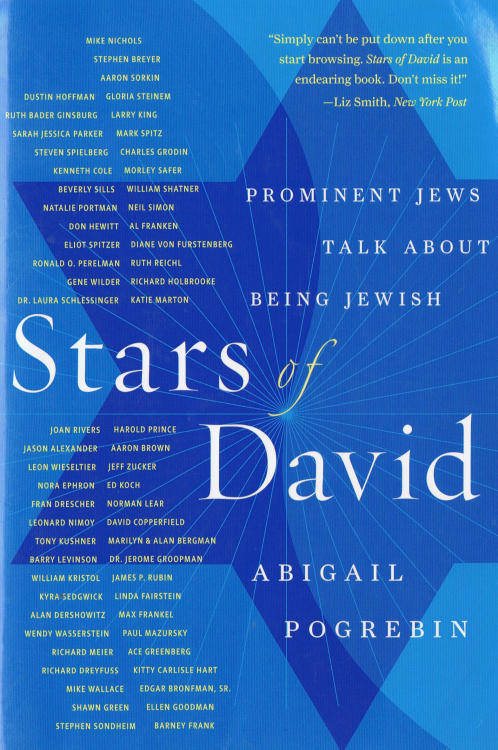 Sometimes it's uncanny how some of Leonard Nimoy's and Spock's experiences parallel each other... like family - Sarek in Spock's case - withholding approval, or the experience of being alienated from one's surroundings and being maligned for it that comes from being different. This and much more is talked about in Stars of David by Abigail Pogrebin. (more)
Sometimes it's uncanny how some of Leonard Nimoy's and Spock's experiences parallel each other... like family - Sarek in Spock's case - withholding approval, or the experience of being alienated from one's surroundings and being maligned for it that comes from being different. This and much more is talked about in Stars of David by Abigail Pogrebin. (more)
Digital Movie
August 16th, 2005
By Christian Bartsch
Als Leonard Nimoy während der Opening Ceremony zur FEDCON XIV die Bühne betritt, tobt der Saal. Tausende Menschen spenden Standing Ovations, während Nimoy es sichtlich genießt, und die Freude der Anwesenden teilt. Es dauert eine ganze Weile, bis sich die Masse beruhigt hat und sie applaudiert erneut wie wild, als Nimoy die Menge begrüßt: "Der Großvater von "Star Trek" ist hier..." (more)
HNR (HollywoodNorthReport)
September 2, 2004
By Robert Falconer
Robert: Ansel Adams once said: “When words become unclear, I shall focus with photographs. When images become inadequate, I shall be content with silence.” Have you ever found yourself in a place that intrinsically begged to be photographed; yet the power and magnificence of the place was such that you believed no photograph could possibly capture its essence?
Leonard Nimoy: I find that experience very often. Years ago—in the 70s, for about a decade—I carried a camera every place I went. And I shot a lot of pictures that were still life and landscape, using available light. I’m still very pleased with some of those photographs and some of them were published in various books I was involved with in the 70s. But I don’t think—unless you are an Ansel Adams and a master of that particular kind of photography—that it makes much sense. My memory of those places is better than my pictures. That’s why I get much more satisfaction out of shooting thematic work that has to do with an idea that I’m searching for, or searching to express. (more)
USA Today
May 11, 2004
By Dennis Vandal
In 2002, he published Shekhina, a book of about 40 photographs that explore his interest in the feminine aspects of Jewish divinity. Many of the images are on display this month at the R. Michelson Galleries in Northampton.
"At the heart of it all is the fact that I was trying to really completely enter into the world of the feminine," says Nimoy, 73. "I didn't want to do misty, cloudy figures. I didn't want to shroud her. I wanted to make her flesh and blood, and I wanted to make her definitively female." (more)
Moment Magazine (article now at slashdocs)
February 2004
Leonard Nimoy, renowned for his portrayal of the Vulcan Mr. Spock on the original Star Trek television series, set aside a highly acclaimed career as an actor and director to pursue the latest segment of his “Jewish journey.” For nearly a decade, Nimoy, now 70, has photographed and developed images of the feminine presence of God, culminating in a book of controversial photographs titled Shekhina. The son of a barber, Nimoy grew up in an Orthodox family in Boston and once thought of pursuing a full-time career as a photographer. The Jewish Museum in New York recently purchased one of his photographs for its permanent collection, and on February 10, 2004, “Shekhina,” a dance based on Nimoy’s photographs will be performed at the Joyce Theater in New York City.Moment: You are famous for playing an alien—a Vulcan—on Star Trek. Have you ever played a Jew?
Nimoy: I was asked to play Morris Meyerson in the television movie A Woman Called Golda and to go to Israel to act in this film. I did some research and read the script and I discovered that Morris Meyerson was a person that I couldn’t identify with, at least I thought not. He was a schlep-along kind of guy, a nice man I’m sure. He and Golda were married in Milwaukee, but she decided that she wanted to go to Palestine for this great new venture to help found a country and he said, I’d rather stay in Milwaukee, and she said, well I’m going to Palestine. He said, OK if you’re going to Palestine, I’ll go to Palestine. But he never was in awe of her mission and she left him behind eventually. I said to the producer, I don’t think I could do a good job here. I don’t think I could find a way to enter this character and he said it’s too bad, because you’d be playing opposite Ingrid Bergman who’s gonna play Golda Meir. Ingrid Bergman. INGRID BERGMAN! With Humphrey Bogart in Casablanca, my favorite movie of all time. So I thought. Weeeell, maybe I could find a way to do this. (Laughter) And I went and I met the director there who I discovered later had not wanted me for the role. He thought I was not the right person for this character. He came from London to Israel. I went from Los Angeles to Israel. We met there and we began to work and one day I had a question in a scene we were about to shoot and he blurted out “What’s the difference? You’re wrong for this role anyway. They should have sent me a Jewish actor.’ (Laughter) I think the schlemiel thought that Ingrid Bergman was Jewish. (Laughter) (more)
Did you know?
- that it took Leonard Nimoy eight years to do Shekhina?
- that he was in New York on the day of September 11th?
"LN: We were in New York in our apartment. My wife had the TV set on, she yelled out, "A plane just hit the World Trade Center"! We both went to the set and watched the second plane hit the second building."
- that Spock's trademark lift of the eyebrow came out of the spur of the moment?
Q: Mr. Nimoy, was it hard to learn to lift one eyebrow in that manner?
trekkieat9LN: It came very naturally. It wasn't something I set out or planned to do. It was something that I did as a natural reaction to something DeForest Kelley said to me one day.
- that the Vulcan greeting is the only thing he took from his ethnic background to incorporate into Star Trek?
Q: I was wondering if you put anything else besides the hand greeting from Judaism into Vulcan culture or Star Trek in general.
ShiraLN: No, the answer is no.
- that he was disappointed in the animated Star Trek?
Q: Were you approached in doing Star Trek: The Animated Series? What did you think of the storylines and working with the original cast again?
kirk1701aLN: That was an interesting project. I was, frankly, disappointed. I think because the animation could not capture the chemistry between the cast members we had on the TV series.
- that there is a role he regretted he did not take?
Q: Have you ever been offered a role that you turned down and regretted doing so?
joannxLN: I was offered the role of "Dracula" in the original Broadway production some years ago. Frank Langella took the job and when I saw the production I decided that I had made a mistake.
For more of the 2003 chat transcript go to STRARTREK.com.
Jewish Journal
December 4, 2003
By Naomi Pfefferman
(...) After Nimoy left home at 18 to study acting at the Pasadena Playhouse, his knowledge of the mamaloshen helped him land roles with visiting Yiddish theater troupes. One highlight was meeting legendary star Maurice Schwartz: "I had an appointment to audition for him at a theater on La Cienega, and as I was waiting for him to acknowledge me I heard his wife say, in Yiddish, 'He looks like the gentile in 'It's Hard to be a Jew,'" Nimoy recalled with gusto. "She didn't know I spoke the language, and I thought, 'This is going to be a snap.'" (more)
Something Jewish
August 28, 2003
By David Silverberg
Whether intentional or not, the 2002 photography collection is raising eyebrows for mixing naked women with tallis and tefillin, already prompting two U.S. cities to cancel tour dates. The controversy has even been dubbed ShekhinaGate.
"I'm surprised by the reaction," says 71-year-old Nimoy from his Beverly Hills home. "Some people think simple entertainment is safer than illumination."
Nimoy talks frankly on his path of spirituality that led to Shekhina, a work inspired by scriptural mythology that "tells us that God created a divine feminine presence to dwell amongst humanity." As if prompted by a routine cue, he describes how his journey was sparked by a synagogue visit when he was nine-years-old in Boston. (more)
Sun Sentinel
February 08, 2003
By James D. Davis
"A number of religions have feminine adjuncts to deities -- a nurturing, mothering, intercessor aspect of the divine," Nimoy, 71, says from Los Angeles. "As a monotheistic religion, Judaism doesn't need that. But it does see feminine aspects to the deity."
In Nimoy's book, the presence takes the shape of a woman -- actually, eight models over the eight years of the shooting project. The women stand, stride, recline, even dance: One of them was a ballerina. Some of them gaze downward, attempting to show the Spirit hovering over humanity.
Many of the models are nude. One is pregnant. Others are partly draped in glowing shrouds, a purposeful reference to a biblical psalm that says of God, "Thou didst clothe thyself with light, as with a garment."
A few of the models wear prayer shawls and phylacteries, a brazen challenge to traditional Jews who would reserve those artifacts to men.
Nimoy's broad goal in the book: "If Shekhina is a creature of Spirit in the flesh, I want to explore all the things that women experience." (more)
Popjournalism
August 2003
David Silverberg
The Star Trek star talks about his photography series "Shekhina" and responds to the stir that followed
Leonard Nimoy is best known for playing the monotone Vulcan named Spock in the Star Trek series, but he's quite talkative when I speak to him. He plugs his first photo book with the zest of a marketing professional.
The 71-year-old actor-photographer's "Shekhina" courts controversy by mixing overt sexuality with religion. One of the featured 55 photos shows nudes clutching Jewish symbols traditionally belonging to male ceremony. Predictably, some American rabbis blasted Nimoy for muddying the waters of decency by sullying Judaism with breast-baring pictures.
"I'm surprised by the reaction," says Nimoy from his Beverly Hills home. "Some people think simple entertainment is safer than illumination." (more)
Daily Hampshire Gazette
The show was organized after gallery owner Richard Michelson discovered Nimoy was coming to western Massachusetts in May to visit the National Yiddish Book Center in Amherst and some of the state's art institutes.
Nimoy and his wife, Susan Bay Nimoy, head a foundation that offers grants for artists-in-residence programs to museums and other arts organizations, including MASS MoCA in North Adams and the Isabella Stewart Gardner Museum in Boston.
Michelson's manager Paul Gulla said the gallery is excited about showing Nimoy's work.
''We've known of his photographs for some time,'' he said. ''I think they make great photographs as figure studies. He's dealing with the feminine nature of God - and sexuality is part of that. It's fine photography.''
In an interview from his home in Los Angeles, Nimoy said he was 13 when he began taking photographs with a Kodak Autographic camera, and developing them in the bathroom of his family's small apartment in Boston, where he grew up.
He's been snapping pictures ever since. He studied photography while a student at the University of California, Los Angeles and, despite his success in Hollywood, considered switching his career from acting to photography in the early '70s.
Along with his work in television, film and theater _Nimoy appeared in several well-known TV series in the late '50s and early '60s, including ''Wagon Train'' and ''Perry Mason,'' to name a few, as well as feature films like ''Deathwatch'' - he has gained recognition as a photographer since his first show in 1973.
''It's always been a part of my life,'' said Nimoy. ''I carried a camera wherever I went.'' (more).
Jewish Journal
October 31, 2002
By Joe Berkofsky
Naked women covered in ... tallitot and tefillin? The black-and-white photographs in "Shekhina" (Umbrage Editions, $39.95) a new book by Leonard Nimoy -- a.k.a. "Star Trek's" Mr. Spock -- have ignited a debate in the Jewish community over art and censorship. (more)
The Seattle Times
October 25, 2002
By Mark Rahner
Nimoy had been scheduled to appear at a Jewish Federation fund-raiser on Wednesday. But after his presentation was canceled, federation director Barry Goren said the nudes in "Shekhina" could be offensive to prospective donors and that Nimoy had contracted to discuss his "Jewish journey." Nimoy said the federation knew about "Shekhina" from the outset and that the cancellation seemed like censorship.
The eyebrow-raising controversy made national headlines, peaking in a "Saturday Night Live" spoof in which "Weekend Update" anchor Tina Fey joked, "Your reign of tyranny is over, Jewish Federation of Greater Seattle! Thanks to Leonard Nimoy, Seattle and its surrounding suburbs will now walk free!" ( The federation, which replaced Nimoy with comedian Al Franken, helped reschedule him with Beth Am.)
Before his presentation yesterday, a relaxed Nimoy, 71, said of the sendup, "I thought it was hilarious. I couldn't stop laughing. My only previous controversy was involving Spock's ears." (Mr. Spock is the name of the character Nimoy played on "Star Trek.")
Nimoy wasn't surprised the cancellation multiplied the attention to his photography. "Is it crass to say it probably worked out for the best?"
But not just in sales. Nimoy, who is not an Orthodox Jew, said, "The book has awakened my own new interest in spirituality and given me a new pathway into it."
As for the controversy surrounding his images, Nimoy said, "The real issue is not religious iconography, it's not nudity, but the elevation of women in the hierarchy of the religion."
That remark drew applause when he repeated it during his slide show last night. "Tonight I'm going to boldly show you what I was not allowed to show you last night," he joked. The crowd — which ranged from teens to the elderly and included a few Christians — sat silently during the presentation and then applauded warmly. (more)
jweekly
October 25, 2002
Joe Berkofsky
NEW YORK -- Leonard Nimoy insists he isn't morphing into the Jewish world's Robert Mapplethorpe.
Yet Nimoy, who won fame as the ultra-rational Mr. Spock in the 1960s TV series "Star Trek," is stirring Jewish passions with his new book, "Shekhina," a kabbalistic term for the feminine aspect of the Divine spirit.
The book is a collection of Nimoy's black-and-white photographs of women, many naked but for prayer shawls and tefillin.
"I don't think I'm quite in the Mapplethorpe territory," Nimoy said, referring to the late photographer of nude figures and graphic homosexual sex.
"I wasn't thinking about profanity when I was doing this" book. "I was thinking beautiful and spiritual."
Yet with "Shekhina," Nimoy, 71, is igniting an artistic debate in the Jewish community over art and censorship that echoes the battles that swirled around Mapplethorpe, and artists like Andres Serrano and Chris Ofili, who created controversial religious imagery. (more)
Jewish Journal
October 18, 2002
The Jewish Federation of Greater Seattle dropped actor Leonard Nimoy from its Oct. 23 fundraiser because of images in his book of photographs. The cover for Nimoy's book, "Shekhina," shows a woman wearing tefillin and her right breast visible through a translucent garment. The work is entirely "reverential," Nimoy told The Associated Press. "It's a photographic essay on the subject of the Shekhina, which is the feminine presence of God, the feminine aspect of divinity."
Federation director Barry Goren told The Seattle Times that he dropped the former star of "Star Trek" after receiving "some expressions of concern." He added that he had little choice. "If you were running a charity fundraising dinner and there were going to be images of naked women or naked women with Jewish ritual objects draped on them, that might be offensive to some folks," he said.
Salon.com
Sep 6, 2002
By David Bowman
I am sitting in Leonard Nimoy's Manhattan living room discussing naked women. Not just any naked women, but Mr. Spock's naked women. Nimoy's naked women. "I Am Not Spock" was the title of Nimoy's first autobiography. "I Am Spock," the title of his second. This on-again, off-again Vulcan science officer has a new book out-- a collection of his photographs of nudes. more
UGO
ca. 2002
By Daniel Robert Epstein
DE: What made you want to include the Vulcan hand sign?
LN: That's what the Shekhina is all about. That's the gesture that represents Shekhina.
DE: Oh, really? So this is something that you have prepared for almost your whole life, it seems.
LN: Yeah, without realizing it.
DE: The critic whose comments are in the book, Donald Kuspit, refers to you as a Jewish heretic. What do you think of that?
LN: I guess maybe I am. I don't know. I'm not uncomfortable with that.
DE: How do you think your fans will react to the new book?
LN: I can't really say that I was concerned with that when I was producing this thing. I think it's my adventure, my trip, my journey, and I guess my attitude is, let the chips fall where they may. (more)
Sun Sentinel
December 21, 2001
By Mark Pinsky
More than half a dozen books have been written about the religion and theology portrayed in the five television series and nine feature films since the show premiered 1966. Nimoy, who was with the show since the television premiere and who directed two of the feature films, says this was ironic, because Star Trek creator Gene Roddenberry "forbade any reference to God or religion" in the series.
That stricture did not keep the show's writers from raising spiritual and ethical issues in the plots, or actors like Nimoy sneaking in some religious symbolism. (more)
beliefnet
Dec. 2001
By Anne A. Simpkinson
When did you start taking photographs?
I've been working with photography for many years. About seven or eight years ago, I started work on a collection of images of the female figure--some of which are on my web site
About three years ago, I was visiting a collector in New York, who has a rather impressive collection of photographs, all based on the human hand. It struck me that I had an image that might be interesting to him and it was the image of the hand in the kabbalistic gesture, the split fingers, that you might be familiar with. [On Star Trek, it was the Vulcan salute.] (more)
Chicago Tribune
October 07, 2001
By Robert K. Elder
Q. What are some of the concepts in the work?
A. The major conflict is between spirituality and materialism. There are other concepts that lurk in the area as well. For example, I'm conscious of the fact that in one of David's psalms he says, about God, `Thou didst clothe thyself with light as with a garment.' And light as clothing is part of what I'm doing with these photographs.
Q. What kind of resistance have you felt regarding your role as celebrity and your pursuits as an artist?
A. I don't know, it's hard. It's akin to the question I used to get years ago, `Do you think you're typecast?' You don't get a call from somebody saying, `We're not going to hire you because you're typecast.' So, it's hard to measure. I realize that I am much better known as an actor/director.
But my credentials as a photographer are real. I started studying photography at UCLA in 1970 under a man who lives in Chicago now, a brilliant artist and teacher named Robert Heinecken. Heinecken was a great motivator, and I think my work jumped forward from that time on and I'm still affected by his teaching, his approach to photography and have always taken it very, very seriously. I'm not frivolous about it. (more)
SF Gate
March 17, 2001
By John McMurtrie
Leonard Nimoy's Personal Quest / The actor seeks the divine in his photography
The wine and cheese are going fast by the time the man of the hour shows up. Wearing dark clothes and stylish glasses, his hair closely cropped, Leonard Nimoy eases into the room largely unnoticed, becoming just another hands-in-pockets visitor in a crowded gallery.
Nimoy likes it that way. The photos on the walls are his, but he'd rather the art itself -- and not its creator -- draw attention. As Nimoy acknowledges, sometimes it's not easy being known as a pointy-eared Vulcan who will appear in television reruns for what may seem like eons.
"I'm trying to reach an audience that is inclined to take the work on its own merits," says Nimoy, who years ago published poetry and, with his "Star Trek" co-star, William Shatner, recorded cover songs. "I understand that in certain quarters there's a disdain for people who cross from one art form to another. . . . I guess that's just the way it is." (more)
Sun-Sentinel
February 03 1999
By Dale Koppel
After the gallery walk, Nimoy met with 15 children from the centre's two therapeutic photography programs: FOTOFriends, for children ages 10 to 12 involved in Alateen; and Project I See, for children ages 11 to 17 who are under court supervision because of abuse, neglect or abandonment.
"The kids in the program can express their feelings through the photographs they take," said Denise Felice, professional photographer and instructor of Project I See.
Nimoy shared his own thoughts about photography with the group.
"I love the way a camera can capture an expression or a shadow," he told them. "You can even stop motion with a camera. Best of all, a camera can keep an image forever."
For the kids in Project I See, whose lives have been in turmoil, keeping something you care about "forever" is significant. (more)
Salon.com takes a good hard look at what is wrong with Star Trek nowadays. Posted Oct-29-1999. Leonard Nimoy gives his opinion on the Next Generation on page 4 of the 5 part article.
Berman's decision to kill Kirk wasn't merely a pragmatic solution to a nonexistent quandary. After all, why couldn't Paramount make films using both casts, at least until the original crew of the Enterprise started dying off in real life? No, his execution of Kirk symbolized a lack of understanding of what made the show so endearing for so long. You can put any group of people in Starfleet uniforms, but if there is no sense of humor, no sense of purpose, no sense of compassion, then it sure as hell ain't "Star Trek."
"There has definitely been a difference in vision than what we were doing, and that's either for better or worse," says Nimoy, who says he does not watch the new shows because he hasn't the time. "You have to give them credit, because, on the one hand, we only lasted three seasons and were canceled. They lasted 12 years with three different shows. If you put the aggregate years together, that's like 30 years of 'Star Trek.' And they have a right to call it 'Star Trek,' but it has evolved into something different. What it is, I don't know -- I don't watch enough of it to pass judgment.
"I can tell you on a very general level I think we had a certain kind of charm and a currency. I felt we were in touch with the time. Now, times have changed, and maybe it's not as easy to grab hold of a Zeitgeist as it was for us. We were dealing with very strong social movements of the time. By that, I mean the civil rights movement, the Vietnam War, overpopulation concerns, the growing awareness of concerns for the planet. We had very rich, fertile territory to plow, and I think we did it very well. I don't know that these people have the same kind of territory to plow, except, 'How are we going to get home this week?' It's not the same, is it?"
Nimoy has never forgiven Berman for the poor handling of Kirk's death -- and for the fact that Braga and Moore, in their original "The Undiscovered Territory" script, had reduced the Spock and McCoy characters to nothing but walk-on parts, another sign of how little these men cared about the original show. Nimoy says he wouldn't have minded so much had he been asked to direct the film before the script was written. Even if the Spock role was to be small, at least as director Nimoy could find some way to give him an identity.
But that wasn't to be.
"I had directed two very successful 'Star Trek' movies, and 'IV,' it's safe to say, is to this day the most successful," Nimoy says. "But the point is, when I was asked to do them, I was brought in first, as the director to make a movie for Paramount Pictures. When Rick Berman announced to me he had been hired as producer to make the next 'Star Trek' movie, I said to him, 'Who's going to direct it?' And he said, 'Well, it would be very exciting to work with you as a director someday,' which I thought was very evasive. Then several months later, after he and his people had done the script, they called me and said, 'We would love to have you direct this movie.'
"Well, this is an entirely different construct than making a movie for Paramount. Now, I'm making a movie for Rick Berman, you see. Well, the script was lousy. I said so: 'This needs major, major work.' They said, 'Well, we don't have time for the kind of changes you're talking about.' So I said goodbye. And then to end it with a fight scene between Kirk and Malcolm McDowell! What's the point?"
Since then, Nimoy has not talked to Paramount about anything related to "Star Trek" -- with one exception: He and business partner John de Lancie (better known as "Next Generation's" Q) have shipped to stores this week an hour-long audio version of their "Spock vs. Q" two-man show, which they've performed at a half-dozen "Star Trek" conventions. Nimoy licenses the character from Paramount; that's the extent of his relationship with the studio.
"Which is a shame," Nimoy says, "since Rick Berman and I used to be friends."
On page 5 of the article he is cited saying that "'De's death is a nail in the coffin' of his ever doing any more 'Trek' films." Little could anyone have imagined in their wildest dreams that neither the Next Generation and the series coming thereafter, nor the passing away of the original actors, could have stopped their brand of Trek to continue to live it's long and prosperous life in 2009. (more)
Reform Jusaism
By Sonia Levitin
1998
So you create your own service -- and do you lead the service?
We split up the service, having different people participate. I lead the service, and so does Melvin -- he's the patriarch of the family.
People at your seder, then, are active participants.
Yes. It's very important to spread the idea that coming out of Egypt, out of bondage, was a liberation process. We need to emphasize that every person is somehow in bondage, so we ask everyone at the seder table to think about what they have liberated themselves from in this past year. What growth, what discoveries have they had? What liberation from previous burdens or commitments or binding concepts that have held them back?
Is there something in your life that was a burden, from which you've been liberated?
Yes, I feel particularly in the past 10 to 15 years I've come out of a cocoon in which I was bound up by obsessive career goals at the expense of personal life. I've lately given myself the license to be much more engaged with my family and our personal activities, and let the career be equal or at best hold second place.
What are some of those activities that you enjoy now?
Taking family vacation and family gatherings, communicating more, being aware of each other more. For years I was so obsessed with work and traveling so much that I missed many aspects of my children's growth. Now each year I try to unbind a little more, spending less time working and more time living a personal life. Fortunately, I am able to do this, economically. Some people can't. But at least they should be aware that there are great family and life experiences going on that you cannot recapture. You cannot recapture the years, but you can repair and rebuild the quality, and that's what I'm trying to do. (more)
Dreamwatch No. 50
November 1998
Paul Simpson.
How did the idea of Alien Voices come up?
About two years ago, I was contacted by some friends who were doing a revival of the original Orson Welles production of The War of the Worlds. They asked me to do the Welles role, which I did. It was directed by John de Lancie, who is a very good (more)
 Nimoy acknowledges that he and everyone associated with Alien Voices was worried about the possibility that today's consumer — so spoiled by high-tech products, so used to mind-boggling special effects in feature films — might not be open to the audiodramatisation concept. Fortunately, Nimoy notes, those concerns proved prettymuchunfounded. "I am finding the audience open to us,very much so," he remarks. "The job is to draw people's attention. Once they become aware of what we're doing and begin to listen,there's a great sense of enjoyment. We get wonderful feedback about the productions we've done so far and we're told that we're getting better and better at them. The trick, really, is to get the audience to try it that very first time." (more)
Nimoy acknowledges that he and everyone associated with Alien Voices was worried about the possibility that today's consumer — so spoiled by high-tech products, so used to mind-boggling special effects in feature films — might not be open to the audiodramatisation concept. Fortunately, Nimoy notes, those concerns proved prettymuchunfounded. "I am finding the audience open to us,very much so," he remarks. "The job is to draw people's attention. Once they become aware of what we're doing and begin to listen,there's a great sense of enjoyment. We get wonderful feedback about the productions we've done so far and we're told that we're getting better and better at them. The trick, really, is to get the audience to try it that very first time." (more)JWeekly
January 23, 1998
By Michael Elkin
The actor, who first encountered fame as the detached Mr. Spock, is emotionally involved in Israel's survival. He has visited the Jewish state several times, the latest sojourn a family affair three years ago.
"It was a bar mitzvah gift for my stepson," Nimoy says.
Visiting Israel "is always an emotional trip," he says, adding that he "has always had fantasies of living there, but, at this point, it's unrealistic."
What is real is his continued commitment to Israel.
"There was a time, years ago, when you couldn't find people in my industry" eager to come out of the Jewish closet, Nimoy says. "It was a time in which name-changing [among Jewish stars] was rampant."
Today, however, "there is a greater sense of security," Nimoy says of his industry colleagues.
"And [the flourishing] of Israel has something to do with that." (more)
via Chicago Tribune
July 14, 1995
By Ian Spelling
"Adam and I were discussing the fact that `Outer Limits' was being revived and that I'd done one," an upbeat Nimoy recalls during a phone conversation from his Los Angeles home. "So we submitted the idea of our redoing `I, Robot.'
"That's how this developed. It was also my choice to play the attorney this time, instead of the reporter."
Nimoy reports that he purposely avoided rewatching the original episode in order to bring a fresh approach to the remake. (more)
Los Angeles Daily News via Sun Sentinel
January 03, 1992
By Bob Strauss
You`d think that Leonard Nimoy would be the Star Trek actor most eager to say goodbye to the whole, as well as the specific, Enterprise. After all, Mr. Spock, his half-alien character, was the science fiction series` most indelible icon, a paragon of Vulcan logic and often poignant when it came to dealing with his own, repressed emotions.
And, of course, there were those ears.
But even though Nimoy is the most insistent of the seven original cast members that Star Trek VI: The Undiscovered Country is their final Starship flight, he bids farewell to the Enterprise with far more ambivalence than he does relief. (more)
Seattle Post-Intelligencer via Sun Sentinel
November 01, 1995
By Steven Goldsmith
After decades of having to correct people, Leonard Nimoy thought the public finally had it straight:
His character is Mr. Spock (the pointy-eared Star Trek alien), not Dr. Spock (the advice-dispensing pediatrician).
Imagine the potential identity crisis, then, that could arise from the honorary doctorate Nimoy was handed in Chicago last week.
Despite such perils, the 64-year-old actor says he is quite enjoying the supernova of honors being bestowed upon him, including dazzling recent profiles in magazines from TV Guide to the New Yorker.
Even his hot-selling new memoir, I Am Spock, is drawing admirers for being a thoughtful manifesto on the ties between an actor and the character he portrays.
"I take that seriously - an actor is responsible for protecting his character," Nimoy said in a recent interview at the University of Washington, where 700 fans waited outside Kane Hall to hear him speak and to get him to autograph copies of his new book. (more)
The New York Times
October 30, 1988
Aljean Harmetz
Leonard Nimoy tries to suffocate his joy, to stuff his happiness back into his chest as if it were a quilt being crammed into a bag too small to hold it. It is unseemly that at the age of 57 he should be so happy. And this exotic feeling, coming as it does after years of being dutiful and earnest and, above all, serious, is built on pain. (more)
Dallas Morning News via Chicago Tribune
December 13, 1987
By Philip Wuntch
In 1975, when Leonard Nimoy wrote his autobiography, the aura of Mr. Spock may have felt like an albatross. In any event, he named his volume ``I Am Not Spock.``
An interview with him tends to disprove the book`s title.
In person, Nimoy is crisp, decisive and even curt. Does that sound like any Vulcans you may know from the ``Star Trek`` series? He seems like the least likely man to direct a charming if slight comedy about the joys of unexpected parenthood. But that`s just what he has done with ``Three Men and a Baby,`` an early holiday box-office winner in which Tom Selleck, Ted Danson and Steve Guttenberg play three Manhattan bachelors whose carefree lifestyle is altered when they find a baby on their doorstep. (more)
Chicago Tribune
November 12, 1987
By Marilyn Beck
HOLLYWOOD — Leonard Nimoy is hoping ``The Good Mother`` will be his breakthrough directorial vehicle.
Nimoy has spent plenty of time on the back side of big-screen cameras, directing ``Star Trek III`` and ``Star Trek IV,`` plus Touchstone`s upcoming comedy ``Three Men and a Baby.``
However, the film adaptation of Sue Miller`s dark, tragic ``The Good Mother`` novel represents his first opportunity to direct a drama. The fact that both Barbra Steisand and Robert Redford were interested in it as a directorial undertaking gives a clue as to the importance of the project.
The importance of the title role has not been lost on dozens of major actresses and their agents. Nimoy said he has been swamped with calls about casting since it was announced that he will direct ``The Good Mother`` for Disney.
Nimoy does not expect to find his leading lady among the Molly Ringwald age group nor the group of actresses whose box office clout to seems diminish as they get ``somewhat long in the tooth.``
``There are many interesting actresses who fall in neither of those groups, including Sigourney Weaver, Glenn Close-and Anne Archer is coming along,`` Nimoy noted. (Source: Chicago Tribune)
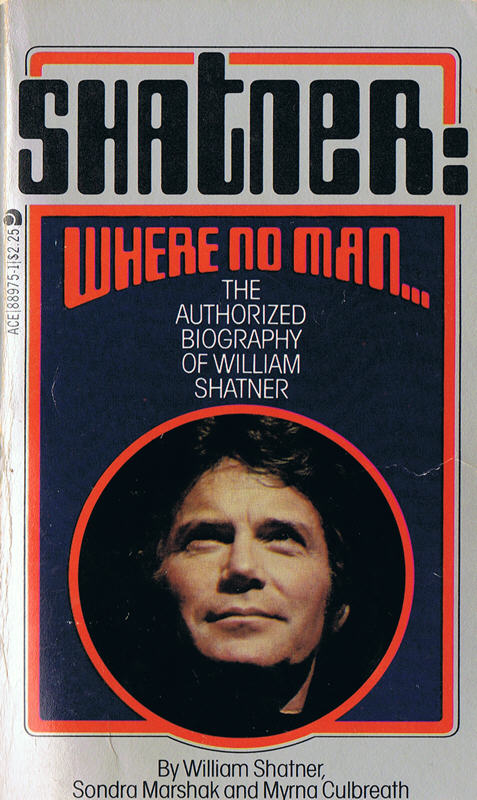 William Shatner, Sondra Marshak & Myrna Culbreath meet Leonard Nimoy for an interview for their book. (more)
William Shatner, Sondra Marshak & Myrna Culbreath meet Leonard Nimoy for an interview for their book. (more)
 Leonard Nimoy Beams Himself Aboard 'Equus' And Out From Under Mr. Spock's Pointy Ears
Leonard Nimoy Beams Himself Aboard 'Equus' And Out From Under Mr. Spock's Pointy Ears
A People magazine article that deals with Leonard Nimoy's approach to playing the role of Dr. Dysart in Equus and his efforts to revitalize the play after 1.150 performances already gone by. Read or download it at the People webpage.
Tri City Herald
October 11, 1972
By Tom Rigert
"In the last 12 to 14 days, I'm beginning to sense the same kind of movement for Sen. McGovern as in the primaries," Leonard Nimoy said at a rally in Richland today.
Nimoy, who stars as Mr. Spock in the television series Star Trek, said he's seen the growing movement during his nationwide campaign for the South Dakota Senator's election.
He has spoken in 30 states in a tour that began in January during the New Hampshire primary.
"I'm at a disadvantage. I've spent most of my previous life on Vulcan, so I don't know too much about the people in this country," he said with a grin, referring to the extraterrestrial background of Mr. Spock.
But he does know that people are intelligent enough to start asking questions about the issues, and these questions will ultimately win the election for Sen. McGovern, he said.
One of the most important questions is what the Watergate affair really means, Nimoy said. (more)
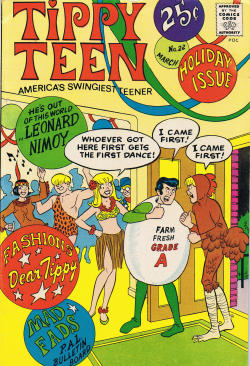
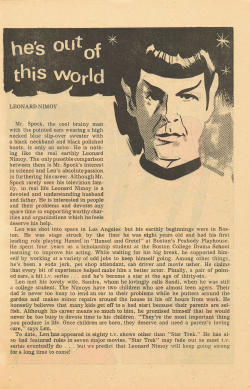 This is actually more of a portrait than an interview with just one quote
This is actually more of a portrait than an interview with just one quote
While I'm filing this concoction under "Interviews", it reads more like someone took a quote or two from other magazines and constructed a tale around them, using well known and publicized bits of data about Mr. Nimoy at that time period. Below are the two passages that might have been taken from real conversations.
"Consideration of others and from others is terribly important to me," Leonard told us. "People who are inconsiderate, who take advantage of a person's time and energies for selfish purposes, who can't be trusted and try to inflict pain on others - such individuals are irritating and despicable."
"Vic [Morrow] and I were very friendly," Leonard said. "We made Death Watch together and we went through much the same period of struggle, at about the same time though Vic hit the big time earlier, with Combat, than I did."




